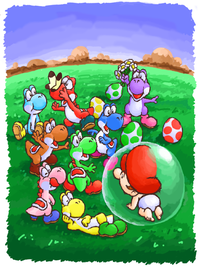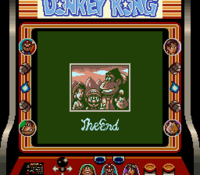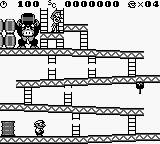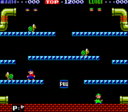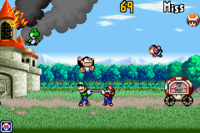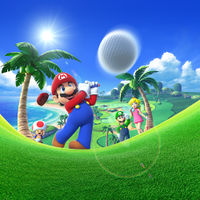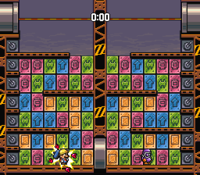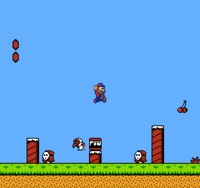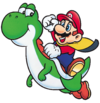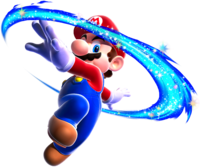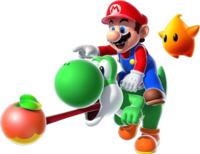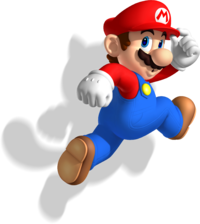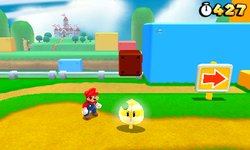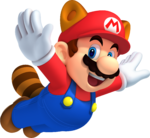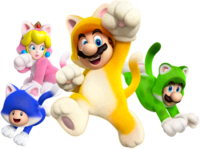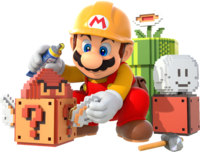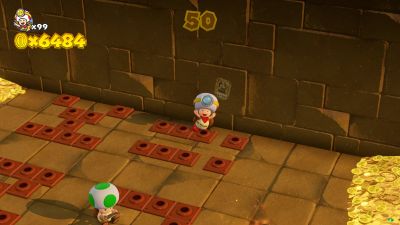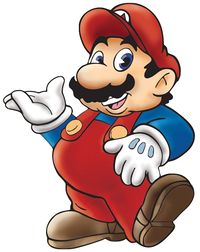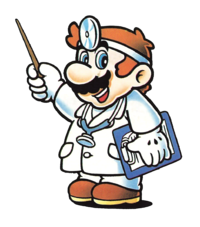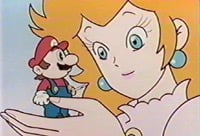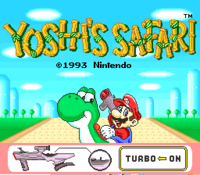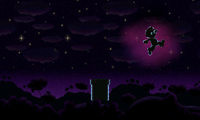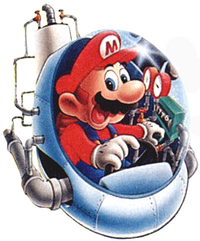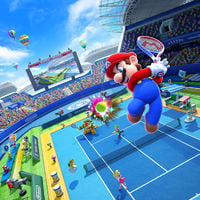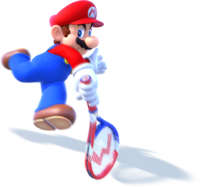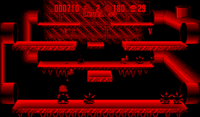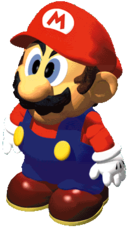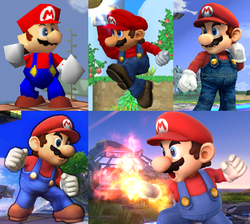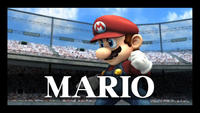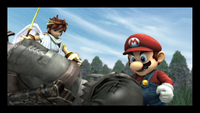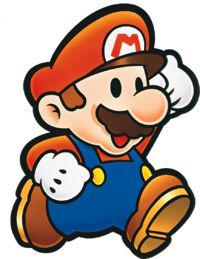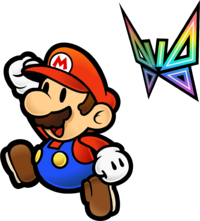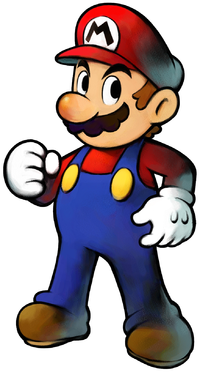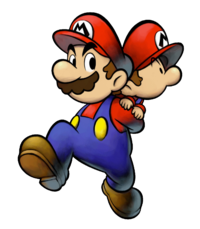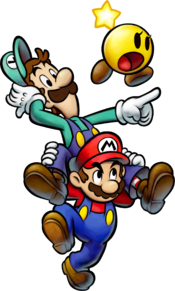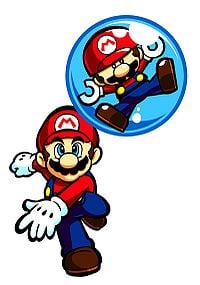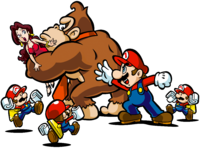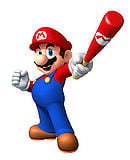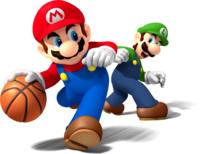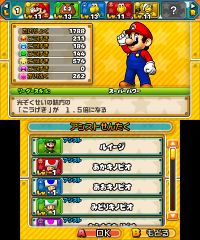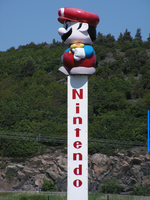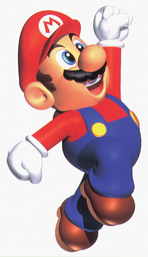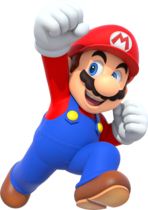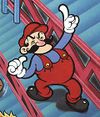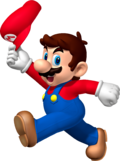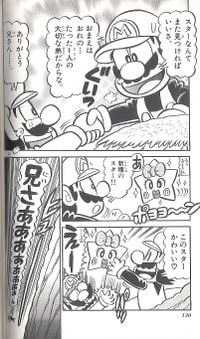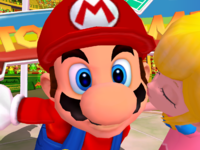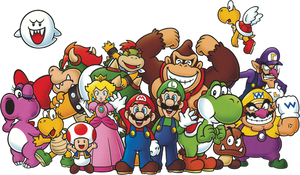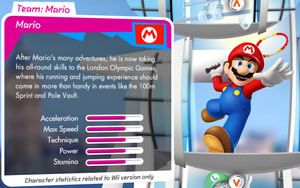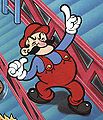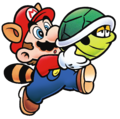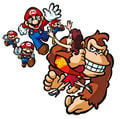Mario
Template:Character-infobox Template:Articleabout Template:Redirectshere
- “It's-a me, Mario!”
- —Mario, Super Mario 64
Mario is the main character and protagonist of the long-running and highly successful Mario franchise. He was created by Japanese video game designer Shigeru Miyamoto and also serves as the main mascot of Nintendo. Mario made his first appearance as the protagonist of the arcade game Donkey Kong, released in 1981. Since Super Mario Bros., his trademark abilities have been his jumping and stomping powers, with which he defeats most of his enemies; and his ability to gain powers with a plethora of items, such as the Super Mushroom, Fire Flower and the Super Star. Games have usually portrayed Mario as a silent character without a distinct personality (Fortune Street is a notable exception). According to Nintendo's philosophy, this allows Mario to fit in many different genres and roles. In most games, he is the hero that goes on an adventure to save Princess Peach from Bowser, but he has been shown doing many other activities besides adventuring, such as racing and sporting with his younger twin brother and others.
Creation
Following the failure of Radar Scope in North America, Nintendo's then-president, Hiroshi Yamauchi, requested Miyamoto's aid in converting unsold Radar Scope units into something that would sell well. Miyamoto conceived the concept of a love triangle and decided to make a game based on the Popeye character. He, however, was denied the rights for the Popeye franchise, so he decided to come up with a new idea using his own characters.
For use in his arcade game Donkey Kong, he created a character named Jumpman, who previously went under other names, such as Mr. Video, and originally, Ossan (the Japanese term for middle-aged man)[1]. This character was given red overalls and a blue shirt in order to make the arms more visible as well as a cap and moustache, as hair and a mouth were impossible to animate on the arcade system.[2] It is said that during the development for Donkey Kong Jr., the Jumpman character was renamed to Mario when an employee at Nintendo of America's office pointed out the similar physical appearances between Jumpman and Nintendo's Italian landlord, Mario Segale.[3][4][5][6] This is later confirmed by Shigeru Miyamoto during a promotional video for Super Mario Maker, which celebrates Mario's 30th anniversary.[7] While initially designed as a carpenter, after an employee noted that he looked more like a plumber, his occupation was changed and Mario Bros. soon followed[8].
History
Background
Super Mario World 2: Yoshi's Island depicts Mario's beginnings by delivery of a stork at nearly the same time as Luigi, suggesting a twin birth. Mario, however, receives help from Yoshis shortly after Luigi has been kidnapped by Kamek, pointing them to Luigi's location. While Mario can still use a power-up, Superstar Mario, the Yoshis must otherwise protect and guide him to Bowser's Castle. Once Mario and Luigi are rescued, the stork delivers them to their parents. Yoshi's New Island, however, later retcons by stating they are the wrong parents. After Luigi is kidnapped a few more times, Mario and Luigi reunite with their true parents in Yoshi's New Island and Yoshi's Island DS.
Super Mario World 2: Yoshi's Island is usually considered as one of the first media chronologically in Mario's history, but a few other sources, usually older than Super Mario World 2: Yoshi's Island, depict different beginnings. In Super Mario Momotarō, for instance, two elderly Hammer Bros. have found and raised Mario, who emerged out of a peach that has fallen from the sky. Mario here resembles his older self, although smaller and without a hat. The story in Super Mario Momotarō, however, is a retelling of a popular Japanese fairy tale and may have no actual bearing on Mario's history. The Nintendo Comics System comic entitled Family Album "The Early Years" is another early medium that depicts Mario's childhood. According to it, Mario has taken an early interest in plumbing, although frequently misbehaving, such as making his father's pipe emit bubbles instead of smoke. Mario is also adept at sports, scoring home runs in his neighborhood softball team. Mario at birth is shown to have full hair on the head and facial stubble that quickly became a mustache. Luigi is also born several years after Mario, later retconned in favor of a twin relationship in the video games.
In Mario & Luigi: Partners in Time, Mario's infant self and adult self unite to defeat the Shroobs and save Princess Peach, although the game takes place from Mario's adult self's setting by labeling his time period as the present and his baby self's time period as the past.
Donkey Kong series
Donkey Kong
In Donkey Kong, Mario, known as Jumpman at the time, is a carpenter whose mission is to rescue his girlfriend Pauline from the clutches of Donkey Kong, who takes her to a Construction Site. Mario can jump over obstacles such as the barrels Donkey Kong throws. Mario also uses hammers as items. Jumping can be used to jump over obstacles only, not to destroy them, as is a prominent feature in later games.
Donkey Kong Jr.
In Donkey Kong Jr., Mario appears as the antagonist, having captured Donkey Kong and holding him in a cage. The protagonist Donkey Kong Jr. rescues his father in the end. Another game depicting Mario as the tamer of Donkey Kong is the Game & Watch title Donkey Kong Circus, in which Mario appears only in the background.
Donkey Kong II
Donkey Kong II serves as a semi-sequel to Donkey Kong Jr. It essentially has the same plot, with Mario being the antagonist.
Donkey Kong Circus
Mario appears as the antagonist in Donkey Kong Circus. Mario is an audience member who laughs at Donkey Kong, the new attraction of the circus, whenever he drops a pineapple or gets hit by fire. In the end of the game, Mario is shown in the construction site where the first game begins.
Donkey Kong Hockey
Mario appears in the game Donkey Kong Hockey as the protagonist. His hockey shot is less powerful than Donkey Kong's but has more range than him.
Donkey Kong (Game Boy)
Mario makes a later appearance in the Donkey Kong series with his updated Super Mario Bros. design in Donkey Kong on the Game Boy. Mario, as well as traveling through the construction site similar to the original Donkey Kong, must travel through additional nine worlds to rescue Pauline. Mario, unlike in Donkey Kong or Super Mario Bros., can perform additional acrobatic maneuvers that may assist him in navigating through levels.
Mario can perform a Handstand move which protects him from any objects falling on him from above. From the handstand position, Mario can also perform the High Jump. The game also features the Back Flip and ropes on which Mario can spin to catapult himself high in the air. Another essential part of his moveset, taken from Super Mario Bros. 2, is Mario's ability to pick up enemies and objects and lift them over his head to throw them. This is also one of the few Mario games in which Mario takes damage and can lose a life from a high fall.
In most stages, Mario has to find the key and take it to the locked door in order to proceed to the next level. As long as Mario holds the key, he has an additional hit point, although he loses the key when he takes damage. He uses Hammers as seen in the original Donkey Kong and constructs temporary Ladders and Roads in order to pass through the levels. Other levels are boss fights against Donkey Kong Jr. and Donkey Kong. In the final fight, Donkey Kong uses several Super Mushrooms to grow to a big size in stage 9-9 of the Tower. Mario must navigate through a level, chasing Donkey Kong and Donkey Kong Jr. to the top of the tower, where he eventually traps Donkey Kong Jr. in a cage and defeats the giant Donkey Kong and rescues Pauline. In the game's credits, however, Mario seems to have reconciled with Donkey Kong since they are shown together with Donkey Kong Jr. and Pauline in a photo in Rocky-Valley.
The ending of the game shows Mario holding Donkey Kong above his head (who is yelling HELP!), with Donkey Kong Jr. standing to the left of him. To the right is what appears to the start of Level 1-1 from Super Mario Bros. This foreshadows the events of both Donkey Kong Jr. & Super Mario Bros.'.
Many of Mario's moves and objectives are carried over to the formerly-planned sequel, Mario vs. Donkey Kong.
Donkey Kong Country 2: Diddy's Kong Quest
Mario makes a cameo appearance in Donkey Kong Country 2: Diddy's Kong Quest. He appears at the end of the game as one of Cranky's Video Game Heroes, along with Diddy Kong, Link and Yoshi. Sonic's shoes and Earthworm Jim's plasma gun can be seen besides a trash can labeled "no hopers." With 39 DK Coins in the original and 67 in the Game Boy Advance version, Mario is the top video game hero.
Donkey Kong 64
In Donkey Kong 64, specifically in a port of the original Donkey Kong game, playable via an arcade set up in Frantic Factory, Mario re-enacts his initial role. The player has to carefully guide him throughout the same construction site as in the original game, while the old Donkey Kong creates mischief down Mario's path. A slight modification has been brought to this port, which is related to the game's objective. In the first run, Mario has to rescue Pauline from Donkey Kong, just like in the arcade classic. However, after Pauline is rescued, the player will be prompted to retry the game and finish it in order to receive a special Nintendo Coin, which replaces Pauline.
Saturday Supercade
Mario appears in several episodes in Saturday Supercade, which was his first television show. His personality on the show was of a heroic person whose goal was to capture Donkey Kong. In "The Great Ape Escape", Mario and Pauline own a circus with Donkey Kong as their circus animal. Donkey Kong escapes by riding a motorcycle, after which Mario and Pauline drive their circus van to chase him. Mario attempts to catch Donkey Kong by disguising himself as a banana and catapulting himself. He tries using sleeping gas on Donkey Kong, but Donkey Kong deflects it and escapes into a nearby prison. In the prison, the criminals join with Donkey Kong and exploit his gullibility by having him perform crimes including theft. Meanwhile, riding on a hot air balloon, Mario and Pauline attempt to lure Donkey Kong with a rope ladder made of bananas. Donkey Kong, however, pops the balloon, so the two then disguise themselves as chefs, but this also fails. During the prison football game, Mario again tries and fails to capture Donkey while disguising himself as a referee. When Donkey Kong and the criminals are finally cornered at the top of the building, Mario, in a police outfit and Pauline tell Donkey Kong that the criminals are tricking him. Donkey Kong then tosses the criminals in the cage and escapes in a hot air football, leading Mario and Pauline to continue chasing him.
In "Greenhouse Gorilla", Donkey Kong is tricked by Mr. X to steal Stanley's metal-eating plant, Herman. While chasing Donkey Kong, Stanley meets Mario and Pauline, where they team up to find Donkey Kong and Mr. X. They find Donkey Kong and Mr. X with the plant in the grocery store, but when Mario tries to capture Donkey Kong with his Vacuum trap, the plant consumes it and the three escape. Mr. X then leads Donkey Kong to a banquet, where Mario, Pauline and Stanley are found disguised as hired help. Pauline convinces Donkey Kong to distrust Mr. X, so Mr. X's plan fails and Donkey Kong then escapes, once again leading the three to chase him.
Mario Bros.
After Donkey Kong, Mario is given his own starring series, beginning with the arcade game Mario Bros. in 1983. Only Mario's physical appearance is taken from earlier titles; Mario is now a plumber working in the sewers of New York and fighting an endless number of creatures, such as Shellcreepers and Sidesteppers. Unlike later games, Mario can jump against the ceiling of a platform from below to stun all enemies walking above it. When Mario approaches the stunned enemies, he kicks the enemies out the screen, rendering them defeated. In the two-player mode, the second player plays as a palette swap of Mario. This character is introduced as Mario's brother Luigi, who wears green, whereas Mario wears red.
A remake of Mario Bros. is included in every Super Mario Advance game, as well as Mario and Luigi: Superstar Saga and Super Mario All-Stars.
Game & Watch series
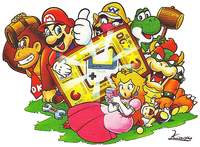
Mario has appeared in several Game & Watch games including Mario's Bombs Away, Mario's Cement Factory, Mario the Juggler and Super Mario Bros. He also appeared in four installments of remakes marketed as the Game & Watch Gallery series and he later appeared in Game & Watch Collection.
In the Game & Watch version of Donkey Kong, the objective is the same as in the arcade version, but Mario must trigger a lever, which causes a hook to appear. If Mario grabs the hook, a peg is removed and he is transported to the starting point. If Mario misses, he falls and loses a life. If Mario removes all the pegs, he defeats Donkey Kong.
In Mario Bros. (which is unrelated to the one in the arcade), Mario and Luigi must cooperate and put pallets on a delivery truck. They have to use conveyor belts to send the package to each other. If they drop a pallet, their boss yells at them. If they drop three pallets, the game is over. In Game & Watch Gallery 3 and in Game & Watch Gallery 4, Wario is the boss and Bowser periodically appears and reverses the conveyor belt directions. Cakes replace pallets in the game.
Mario is featured in Mario the Juggler, a Game & Watch game based on the very first one, Ball.
Mario must safely deliver bombs in Mario's Bombs Away, avoiding oil spills and torches.
In Mario's Cement Factory, Mario must move cement from hoppers into cement trucks by putting them on conveyor belts. The conveyor belts can hold only three hoppers. If the hopper overflows, some cement can land on a worker, making Mario lose a life. Mario can move by using an elevator, but if he moves when the elevator is not there, he falls and loses a life. If Mario stays in the elevator for too long, he can be crushed, or he can fall and lose a life; there are safe zones to circumvent this. In the remake in Game & Watch Gallery 4, Yoshi and Toad appear as background characters. Boo can appear and interfere with the work. Mario can fall from the elevator, but when he touches the bottom ground, he gets a miss.
Super Mario Bros. in the Game & Watch series plays almost the same as the original game for the NES. This version, however, is simpler and shorter.
Mario has also appeared in various heavily toned-down games on the Game Watch, a wristwatch that can tell time and play games. The games are based on Super Mario Bros., Super Mario Bros. 2, Super Mario Bros. 3, Super Mario World, Super Mario Kart and Donkey Kong.
In the modern games of Game & Watch Gallery remakes, Mario also takes some roles previously taken by other characters. Other times, he is a non-playable character. In Fire, for instance, he and Luigi rescue Toads, Yoshis and Donkey Kong Jr.s from a fire. In another example, in Chef, Peach must cooperate with Mario and Luigi to feed Yoshi. Mario or Luigi throw the food and Peach can catch them in her pan.
Mario Golf series
Mario has first appeared in any sports game in Golf, although his proportions are more realistic and he wears simply pants and a shirt. In addition, in Japanese versions of Golf, Captain Rainbow would later identify the character as a more generic Ossan (although this was one of Mario's initial names during development of Donkey Kong). The gameplay is fairly simplistic, although there are obstacles that can impede the ball from landing into the hole. Mario again appears in Family Computer Golf: Japan Course, although he is depicted in his normal overalls and his appearance is more akin to his normal design. Luigi also appears. In Family Computer Golf: U.S. Course, the companion of Family Computer Golf: Japan Course, Mario has a blue shirt and red-and-white striped overalls.
In NES Open Tournament Golf, taking place in Earth, Mario retains his blue shirt and red-and-white striped overalls. Princess Peach is depicted as Mario's caddy, who helps carry Mario's golf equipment.
In Mario Golf for the Nintendo 64, Mario appears with Luigi in the 18th hole of Mario's Star. His drive is 270 yards and his shot is Draw. He must be unlocked in single player mode, but he is default in multiplayer mode. Mario also appears in the Game Boy Color version under the same name, although this one is drastically different from the Nintendo 64 version and it can interact with it. The game also features a story mode, although Mario and other Mario characters are not playable. Mario also appears in the Japan-only Mobile Golf, although he is unlockable only through the connection of a mobile phone network.
Mario has also appeared in the opening in Mario Golf: Toadstool Tour. Mario unintentionally interferes with Bowser's chasing Wario and Waluigi by hitting Bowser's hand with a golf ball. Bowser drops the Bob-omb on Wario and Waluigi, creating an explosion in the structure. This surprises Mario, Luigi, Princess Peach and Princess Daisy. At the end, Bowser, Wario and Waluigi growl at a confused Mario. In Mario Golf: Toadstool Tour, Mario is a default character in all modes. His shot is 212 yards (280 yards with a star) with a high, straight trajectory. Although he can hit farther than many characters, his shots are more influenced by the wind due to the high trajectory. He has a strong impact and spin, but relatively weak control. When he hits a Nice Shot, the ball is encased in flames. As with Mario Golf for the Nintendo 64, Mario Golf: Toadstool Tour features a different handheld variant entitled Mario Golf: Advance Tour, which continues the story from the Game Boy Color version of Mario Golf. As with its predecessors, Mario and other Mario characters are not playable in the story mode.
Mario returns in Mario Golf: World Tour as a default character. His combination of high drive (surpassed only by Bowser, Donkey Kong and Rosalina) and straight trajectory (making him the character with the highest drive with a straight trajectory) makes him a versatile character, suited to perform well in many golfing maneuvers. Mario also has a gold variant, featuring identical stats and inability to use items, but awarding Mario with a coin per yard depending on how far the ball travels, similar to a permanent Gold Flower.
Wrecking Crew series
Wrecking Crew
In 1985's Wrecking Crew, Mario and Luigi appear as workers on a demolition site, similar to Jumpman working as a carpenter in Donkey Kong. They use hammers similar to those previously seen in Donkey Kong against Foreman Spike. Unlike its Japan only "sequel", Wrecking Crew '98, the game has no specific plot. In this game, Mario wears a helmet, shoes and dark red overalls. Mario faces Gotchawrenches, Eggplant Men and Foreman Spike. In this game, Mario must break all the stone walls before the enemy can. Mario can defeat enemies by trapping them in drums. Foreman Spike can attempt to break blocks himself or push Mario, but Mario can hit him with his hammer and cause him to fall. If Mario stays too long, a Fireball appears to hinder his progress.
Mario reappears in Vs. Wrecking Crew, an arcade game for the Nintendo Vs. system. The game plays similarly to the original with the addition of simultaneous 2-player mode, where Mario and another player compete.
Wrecking Crew '98
In Wrecking Crew '98, Mario finds Mushroom Kingdom covered with Bowser's new high-rises. Foreman Spike also makes a reappearance along with several other enemies from Wrecking Crew, this time helping Bowser. These buildings negatively impact Mushroom Kingdom's environment, so Mario must demolish these structures.
Unlike in the first game, Mario can hinder his opponent's progress by raining panels on them. To clear the stage, Mario must demolish blocks or arrange three consecutive panels vertically or horizontally. If four or more panels are aligned, Mario can rain panels onto his opponent. If he clears the field, he receives a Mushroom, boosting his offensive combos toward his enemy.
Super Mario series
Super Mario Bros.
Since Super Mario Bros., Mario is portrayed living in the Mushroom Kingdom. In the game, Mario's objective is to rescue Princess Toadstool (later known as Peach) from Bowser, the King of the Koopas. The game is the first in the series in which regular enemies such as Goombas can be defeated and Koopas can be stunned by stomping on them from above. Mario can also gain power-ups and coins from jumping against Question Blocks and Brick Blocks. Mario begins the game as Small Mario, who loses a life from any enemy attack. By using Super Mushrooms, Mario grows into Super Mario, who has an additional hit point (reverting to Small Mario after being hit). Super Mario has access to the Fire Flower, which lets him throw Fireballs that can knock out enemies such as Koopas or Bowser Impostors. Mario can also become invincible for a short amount of time with the Star.
Mario's role and powers remain mostly the same in all entries to the series except for Super Mario Bros. 2. While new power-ups and moves are introduced, there is no deviation from the basic formula; Mario's basic appearance is unchanged and his personality remains unwritten. Despite this, Mario in the later games has adapted this depiction. Mario's eye color, mustache shape, hair style, cap shape and face shape are all derived from Super Mario Bros.
Super Mario Bros.: The Lost Levels
Super Mario Bros.: The Lost Levels, the sequel of Super Mario Bros. features Mario and Luigi's having to rescue Princess Toadstool from Bowser by traveling in new various different lands of the Mushroom Kingdom. The setting, however, is noted as a parallel world of the original Mushroom Kingdom, according to the Japanese manual. A notable harmful element to Mario introduced Super Mario Bros.: The Lost Levels is the Poison Mushroom, which can power-down or even defeat Mario. Mario's traction and jumping height remain the same, while those of Luigi are changed to differentiate him more from Mario. Luigi jumps higher than Mario but has less traction. This would be a distinguishing feature used in future games.
Super Mario Bros. 2
In the story of Super Mario Bros. 2 based on the Japanese game Yume Kōjō: Doki Doki Panic, Mario has experienced an dream one night. The fairy like beings from the land of Subcon inform him that King Wart has taken over the land of Subcon and that they need Mario's help to defeat Wart. After awakening from his dream, however, Mario dismisses the dream and returns to sleep. The next day, Mario along with his friends Luigi, Princess Toadstool and Toad decide to go on a picnic. However, while searching for a proper place, Mario and his friends notice a cave and decide to explore within it. After entering the cave, the four friends are transported to Subcon. Remembering his dream, Mario and his three other friends decide to save Subcon from Wart and the 8 bits. Throughout their adventure, Mario and his friends defeat many of Wart's members, including Birdo and Mouser. Eventually, Mario and his three friends confront Wart himself in a battle. After defeating Wart, Mario and his friends save the Subcon fairies and Subcon.
While the four heroes celebrate their victory, Mario is seen to be awakening during the end of the game, implying the message that the whole adventure is simply a part of Mario's dream. The spiritual sequel, BS Super Mario USA, explains that Subcon is a dream world and, while Mario and the others initially thought it is all a dream, they learn the truth about the realm when they are called back into the world to save it from Wart again. They must collect Gold Mario Statues in each level, defeat the boss and find Wart.
In contrast to the other characters, Mario is a well-balanced character with no special abilities in Super Mario Bros. 2 and its sequel, which has the same gameplay mechanics. The gameplay of the two games is vastly different than other Mario titles: enemies can no longer be defeated by stomping them and Mario gains the power to pick up enemies, lift them over his head and throw them. This feature is later reused in the Game Boy version of Donkey Kong and the Mario vs. Donkey Kong series of games.
Super Mario Bros. 3
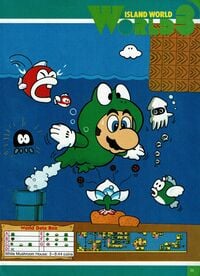
In Super Mario Bros. 3, after Bowser has invaded again, Mario and Luigi travel through eight kingdoms, in which the kings have been transformed into different creatures by the seven Koopalings. During Mario's quest, he is repeatedly sent letters by Princess Toadstool, who encloses power-ups for him. Eventually, Toadstool is kidnapped, but the Mario brothers save her from Bowser in the Dark Land. Super Mario Bros. 3 introduces a plethora of new power-ups aside from the Fire Flower, including Super Leaves, Tanooki Suits, Frog Suits and Goomba's Shoes. He also encounters new enemies, such as Thwomps, Dry Bones and Boos.
Super Mario World
Super Mario World introduces Yoshi as a sidekick character to Mario. Mario can ride Yoshis and so gain varying new powers. Mario meets Yoshi on a holiday in Dinosaur Land, where Bowser kidnaps Toadstool again, forcing Mario and Luigi to rescue her once again. Super Mario World is the first Mario game to have a second jump button for a different jump - the Spin Jump- with which Super Mario can destroy Rotating Blocks from above or jump off Yoshi's back; he can also use it to avoid certain obstacles or defeat foes. Mario can use Cape Feathers to turn into Cape Mario, allowing him to take off from the ground and stay in the air for quite a while. Mario can also use Grab Blocks and throw them at enemies or obstacles.
Mario and Luigi defeat the Koopalings in their castles, rescue the captured Yoshi Eggs and defeat Bowser in the Valley of Bowser, rescuing Toadstool and taking her home to Yoshi's Island to continue their vacation.
Super Mario 64/Super Mario 64 DS
In Super Mario 64, Mario is invited to have a cake with Princess Peach at her castle but finds the castle taken over and Peach kidnapped by Bowser when he arrives there. In order to save Princess Peach, Mario has to collect the castle's Power Stars to advance further and defeat Bowser. When facing off against Bowser, Mario grabs his tail and spins him around to throw him off of the fighting platform. After being rescued, Peach kisses Mario and bakes him the cake.
Brought into a three-dimensional enviroment, Mario gains a larger variety of moves.
He can jump in multiple ways - besides the basic jump, jumping from a standstill while crouching results in a backwards somersault; crouching from a run then jumping gives a Long Jump; Mario can jump higher through consecutive jumps in a run (the Triple Jump); a side somersault can be performed by quickly changing direction; and Wall Kicks were introduced, allowing Mario to gain height by jumping off a wall. More offensive options are also available: he can punch, kick, slide attack and use the Ground Pound; while he can also crawl under low barriers.
Power-ups are gained by collecting caps from Exclamation Mark Blocks: red blocks give Wing Caps, green blocks Metal Caps and blue blocks Vanish Caps. These are temporary, however, and do not fulfil the traditional role of power-ups in giving Mario additional hit points - instead, a Health Meter is introduced for the first time since Super Mario Bros. 2. Mario takes damage not only from enemy hits, but also from falling from great heights and from time spent underwater. The meter is primarily refilled by collecting coins, but air bubbles underwater or swimming on the water's surface also replenish it. Finally, Mario can lose his normal cap, whereupon he takes greater amounts of damage until he retrieves it.

In the game's remake, Super Mario 64 DS, Mario is once again invited to Peach's castle for cake, along with Wario and Luigi. However, some time after entering, Bowser overtakes the castle. The trio is thrown behind locked doors, with Mario being sealed away by Goomboss, who keeps the key to his door. Yoshi, who has avoided capture by sleeping on the castle's roof, is able to find a portrait of Mario in Peach's room and finds Goomboss. After defeating him, Yoshi unlocks Mario's door with the key he receives.
From then on, Mario is an additional playable character. He is required to rescue Luigi (while Luigi is needed to rescue Wario). Mario is also required to enter the final level to rescue Princess Peach. Mario has average stats, with decent power, speed, swim, and jump. His special ability is the balloon floating power gained by the Power Flower. Mario can still use the Feather, this game's equivalent to the Wing Cap, which gives him more abilities than the other characters. Mario is also the only character that can wall jump. Other characters can transform into Mario, gaining his appearance but not his voice, by putting on Mario's Hat. Mario himself can transform into Luigi and Wario this way but not into Yoshi. The game's story is otherwise identical to that of the original game.
Super Mario Sunshine
In Super Mario Sunshine, Mario, Peach and Toadsworth travel to the tropical island of Isle Delfino to have a vacation. However, upon arriving on the Delfino Airstrip, they notice some type of Goop is covering half the area. Mario, responding to Toadsworth's request for help, discovers F.L.U.D.D. and, with his help, destroys the Polluted Piranha and Goop Generator, cleaning the airstrip. Soon after, however the police arrests Mario and takes him a jail on the main island.
Mario is then placed on trial against the citizens of Isle Delfino, represented by a Pianta Attorney. During the trial, the attorney explains that Isle Delfino is covered in Goop by an unknown entity, though descriptions from various anonymous eyewitnesses have suggested that Mario has vandalized Isle Delfino. Peach and Toadstool tried objecting against the attorney, but the judge overrules the objection quickly, sentencing Mario to clean the island of the Goop as community service before leaving, while returning the island's power by collecting Shine Sprites, the island's source of sunlight.
Shadow Mario soon captures Peach, taking her to Pinna Island. From there, Mario uses a cannon in Delfino Plaza to come after her and, after chasing Shadow Mario through the island's theme park, arrives at a lake where Shadow Mario unveils Mecha-Bowser, a huge Bowser-like robot. However, he defeats the robot by using Water Rockets. It is here that Shadow Mario revealed himself to be Bowser Jr., Bowser's only child. Bowser Jr. then reveals that he had taken Peach because Bowser has told him that Peach is his mother (though Bowser later admits this was a lie meant to get Bowser Jr. to kidnap Peach) and that she is "kidnapped by a bad man named Mario..." Mario, Peach and F.L.U.D.D. also learn that Bowser Jr. has planted the Graffiti so Mario can be sent to prison, but it fails. Bowser Jr. then escapes and he and Peach fly to Corona Mountain.
Mario later arrives at the top of the mountain, where Peach, Bowser and Bowser Jr. are sitting in a hot tub. The interruption enrages Bowser, leading him to fight Mario - but despite having help from Bowser Jr., who is firing Bullet Bills from his raft, Mario still manages to ground-pound all five sections of the hot tub, causing it to flip, sending Mario, Peach, Bowser and Bowser Jr. falling to the ground. Mario and Peach land on an islet west of Delfino Plaza, where Mario also finds F.L.U.D.D. lying on the ground, highly damaged from the fall and stress of the battle. F.L.U.D.D. then asks if he had truly assisted Mario before shutting off. The two then watch as the final Shine Sprite falls to the Shine Gate, restoring light to the island.
Mario and Peach are then seen at Sirena Beach, Mario still upset his loss of F.L.U.D.D. Both then turn around to see the Toads that came with them to the island, one holding F.L.U.D.D., who is now fixed and says, "The vacation starts now!"
The game removes most jumping, punching and kicking abilities of the previous game and replaces them with F.L.U.D.D.'s powers. Mario can spray water at enemies and clear Graffiti. Expansion Nozzles for F.L.U.D.D. can make Mario hover in the air for a short while, make him run at a turbo speed, or rocket high up in the air, although Mario can hold only one Expansion Nozzle at a time. Water for F.L.U.D.D. can be refilled at any body of water in the game or with Water Bottles. Mario can also ride Yoshis. In the Secret Levels of the game, Shadow Mario takes F.L.U.D.D. away from Mario, leaving him only with his basic jumping abilities and the Ground Pound to beat the stage. When Mario loses his cap in Super Mario Sunshine, he takes damage from the sun.
New Super Mario Bros.
New Super Mario Bros. depicts Mario in a similar plotline and game design to Super Mario Bros. The beginning of the game shows Mario and Princess Peach taking a walk outside of Peach's castle, when both see lightning hit the castle, startling them. Mario quickly runs off to check it, while Peach stays behind and is thus kidnapped by Bowser Jr. The lightning bolt at the castle was a distraction for Mario. Throughout the game, Mario chases Bowser Jr. in order to save Princess Peach, battling him in his fortress towers.
The traditional Super Mushroom and Fire Flower return, but power-ups also include further size-changing effects induced by the Mega Mushroom and the Mini Mushroom. The Mega Mushroom lets Mario grow to a giant size, being able to crush all enemies and obstacles like pipes, while the Mini Mushroom has Mario shrink to a tiny size, which gives him access to small pipes.
Throughout the game, Mario will have the option to travel through eight worlds or bypass a few. Mario first faces Bowser at the first of the eight castles, where Mario presses a switch, causing Bowser to fall into the lava. However, Bowser survives as a skeletal version of himself, known as Dry Bowser. Dry Bowser is fought again in the eighth castle, although he is defeated. In each castle, Mario encounters many familiar baddies but with upgraded powers and who pose a grave threat to the plumber; he eventually defeats every one of them.
Mario eventually arrives at Bowser's Castle, where Peach is taken after Mario defeats Dry Bowser. Here, Bowser Jr. throws Bowser's bones inside a bubbling pot, reviving him as a somewhat larger version of Bowser. However, despite his larger size and extra strength, Bowser is still beaten when Mario presses the switch, causing Bowser and his son to fall into a pit and freeing Peach.
Super Mario Galaxy
Super Mario Galaxy starts with Mario's invitation to the Star Festival by Peach, who has something to give. The event is interrupted by Bowser, however, when he abducts the Princess. Mario, after hearing Bowser's plot to create an empire at the center of the universe with Peach, gets blasted by Kamek and fails to stop Bowser. When later recovering in the Gateway Galaxy, Mario is asked by Rosalina to rescue the Power Stars and Grand Stars to power her Comet Observatory, which can help take them to Bowser and Peach. Mario is given the Baby Luma, who accompanies him and allows him to Star Spin. Throughout the game, Mario also receives letters from Peach, who sends him 1-Up Mushrooms.
After several encounters with Bowser, Mario defeats him in Bowser's Galaxy Reactor. When Mario rides on the final Grand Star, Bowser's star explodes and creates a black hole. Baby Luma shocks Mario by throwing himself to the black hole to prevent Bowser's black hole from consuming everything around it, including Mario, Princess Peach and Princess Peach's castle. After a big explosion, Mario reappears in an unknown location in front of a large, floating Rosalina. Rosalina reassures him that this explosion is just the mark of a new universe. Mario then awakens in a restored world, near Peach's Castle. He also sees Bowser and Princess Peach awaken, intact. He takes time adjusting to this new world around him before happily embracing it. During a special cutscene after Mario has collected 120 stars, Rosalina thanks him before leaving in her Comet Observatory.
Most of the jumping mechanics present in Super Mario 64 such as Long Jumps, Somersaults and Triple Jumps return. New powers include the Star Spin (which replaces Mario's punch/kick/slide offensive moves in Super Mario 64) and the Wii pointer, which can be controlled independently from Mario. The Wii pointer can shoot enemies or grab Star Bits without controlling Mario. Additionally, Mario can get assistance by another player in Co-Star Mode, who can help gather Star Bits, shoot Star Bits, stun enemies and assist in his jumping. Finally, Mario can find new sets of temporary power-ups that aid him in completing levels such as the Bee Mushroom, Ice Flower, Red Star, Rainbow Star and Fire Flower.
New Super Mario Bros. Wii
Mario's role and basic abilities in New Super Mario Bros. Wii remain the same as its predecessor, although there are a few added power-ups, such as the Propeller Mushroom and the Penguin Suit. The story, while still basic, is slightly different - in the cutscene at the beginning of the game, Mario, Luigi and many Toads, including Blue Toad and Yellow Toad, are celebrating Princess Peach's birthday when a cake suddenly walks into the castle. When Peach moves closer to the cake, Bowser Jr. and the Koopalings jump out of the cake and throw it onto Peach. Mario, Luigi and the Toads then give chase and Mario once again fights his way through eight worlds in his attempt to rescue Peach. After the Mario rescues Princess Peach, the princess tells Mario about secret World 9, extending his adventure.
Super Mario Galaxy 2
Super Mario Galaxy 2 has Mario involved in a more minimalist story compared to its predecessor, Super Mario Galaxy. Before arriving at the castle, Mario finds Luma lying on the ground. Luma then flies into his cap again, giving him his old spinning ability. However, when Mario arrives at Princess Peach's castle, a Giant Bowser kidnaps Peach. Mario gives chase, using a Launch Star.
After finding a star in the first Galaxy, Mario finds a small planetoid that a group of Lumas, led by Lubba, are using to travel around. Lubba then explains that earlier, Bowser found them, took their star power and left the ship in disrepair. The crew of Lumas then use their power to transform the ship, giving it the appearance of Mario's head and it is named the Starship Mario. Being named the captain, Mario flies off to collect Power Stars in order to reach Bowser and Princess Peach.
Aside from additional power-ups and the addition of Yoshi, the gameplay is identical to the first Super Mario Galaxy game. Mario defeats Bowser and saves Peach in the end. Rosalina and her Comet Observatory appear before Mario and Peach. Rosalina thanks Mario for watching over the Luma that he has found and the Luma returns to the Comet Observatory along with Mario's hat. Mario and his companions return to the Mushroom Kingdom.
Super Mario 3D Land
Mario appears in Super Mario 3D Land for the Nintendo 3DS. He uses several classic power-ups, notably, the Tanooki Suit from Super Mario Bros. 3. He once again saves Princess Peach from Bowser's clutches.
After a storm, all the Tanooki Leaves are blown from the Tail Tree outside Peach's Castle. The next day, Mario and three Toads investigate the scene when they notice a floating letter. They open it to discover that Bowser kidnapped Peach while she checks the damage to the tree. Mario and the Toads then run to rescue her. During the adventure, Mario battles several enemies old and new, including Boom Boom and Pom Pom. While running through the worlds, Mario receives letters from Peach to learn about her situation. Mario also encounters Bowser Impostors throughout the adventure.
Mario fights Bowser at Bowser's Castle, activating the switch on the other side of the bridge and sending Bowser into the lava. The area beside the castle contains only a cage lying on its side, however. He enters a door and finds Peach, but, upon running over to her, he finds out that it is only a wooden cutout. Bowser then emerges, carrying the real princess, and flees to his second castle.
After heading through another level, Mario reaches Bowser's second castle and the Princess, this time tied to the flagpole. Bowser then appears and the two begin their battle. This time, Mario has to navigate an obstacle course to get to the bridge and eventually the switch at the end. He pushes this, sending Bowser into the lava below. Bowser quickly emerges from the lava, however, and Mario has to reach another switch in order to actually defeat him. Pushing the switch once again sends Bowser falling into the lava below once more. Mario then reappears back at the flagpole and frees the princess. Mario, along with three Toads, then use Super Leaves to get themselves and the princess back home.
Some time after that, Mario receives a letter from Luigi, depicting Luigi in captivity. Mario runs through Special 1 and frees Luigi from Dry Bowser. Then, yet again, Peach is captured by Bowser. Mario goes back to his castle and defeats him once more. Once Mario gets 5 Stars in his profile, the level Special 8-Crown is unlocked. There he goes through an obstacle course where Boom Boom and Pom Pom are fought for the last time. This time Boom Boom has a track of flames. When they are defeated, a giant "THANK YOU" is appears while Toads surround the final Goal Pole of the game.
New Super Mario Bros. 2
Mario once again appears as the main protagonist of New Super Mario Bros. 2. In this game, Mario can once again become Raccoon Mario, first seen in Super Mario Bros. 3. Gold Mario (as well the Gold Flower) is introduced, as Mario's newest form. In this form, he can throw fireballs which transform solid objects (blocks) into coins for him to collect. It is also the introduction of White Raccoon Mario, a form obtainable from Invincibility Leaves gotten from Assist Blocks. The form gives Mario the power of invincibility and all of the abilities of Raccoon Mario.
In the game, Mario and Luigi are visiting Princess Peach and leave her Castle in Tanooki form, with the princess waving them off, to collect Coins in the sky. As soon as they land, the Koopalings appear in the Koopa Clown Car and slam into the ground, causing the brothers to lose their raccoon powers. They reveal that they have taken Princess Peach once again and the brothers give chase. As they travel through the six worlds, the Bros. must find secret worlds, battle Reznors, who make a return, the Koopalings and search for coins. At the very end they confront Bowser, who is powered up by the Koopalings after his first defeat. However, in classic Mario style, the Mario Bros. use a switch to drop Bowser into a pit. Peach is rescued and the brothers return home.
There is another mode in the game, Coin Rush, in which Mario must collect as many coins as possible in three random courses within the time limit and without dying once. There are + Clocks scattered throughout the courses, while Mario also gets more time by hitting Checkpoint Flags. Reaching the top of the flagpole doubles Mario's coin count and defeating enemies as Gold Mario and/or after a Gold Ring is triggered will award additional coins.
New Super Mario Bros. U
Mario appears again as the protagonist in New Super Mario Bros. U. Once again, he must save the Mushroom Kingdom from Bowser and his minions as he travels with his allies Luigi, Blue Toad, Yellow Toad and his new allies, Miis. After Bowser kidnaps Peach, Mario and his allies crash into a tree, releasing Super Acorns. He gets a new form, Flying Squirrel Mario, when he collects them. In this form, he can glide and cling to walls. The upgraded P-Acorn allows him to fly indefinitely. His old powerups, including, but not limited to the Mushroom, Fire Flower, Ice Flower return. The Penguin Suit and Propeller Suit from New Super Mario Bros. Wii also return, but they are found only in certain Toad Houses and in Challenge Mode.
In this game, Mario discovers Baby Yoshis that aid him in his adventure by providing light, emitting bubbles, or floating. During his adventure, he encounters new enemies alongside the old enemies, including, but not limited to Waddlewings, Nabbits and Goombrats. To save Princess Peach, Mario must travel to a Koopaling's airship and defeat that Koopaling to proceed. Meanwhile, Bowser modifies Peach's Castle according to his tastes. When Mario finally arrives at Peach's Castle, it is conquered and he must enter the modified castle to meet Bowser and rescue Peach.
Unlike in New Super Mario Bros. Wii, when Mario collects 99 lives, he keeps his hat.
In the downloadable content New Super Luigi U, Mario himself does not appear, the first time this has occurred in the entire Super Mario series. However, in the opening sequence, his hat appears on the table. Additionally, at the beginning of the Frosted Glacier level Broozers and Barrels, a snowman with Mario's face and a hat with his "M" on it can be seen.
Super Mario 3D World
Mario returns in Super Mario 3D World, alongside Luigi, Princess Peach and Toad. An all-round character, in a similar way to Super Mario Bros. 2, lacking the special abilities of the other three characters. After Bowser has kidnapped the Sprixie Princesses, Peach falls in the pipe that leads to Sprixie Kingdom while Mario, Toad and Luigi follow. There, they cooperate on their adventure to reach Bowser. During the adventure, Mario encounters new items, most notably, the Super Bell, which transforms him into Cat Mario. He also encounters new enemies, such as Cat Goombas and old enemies, including Chargin' Chucks. Boom Boom and Pom Pom also reappear to hinder Mario's progress while new bosses, such as Hisstocrat are additional impediments. Once Mario and his teammates reach the end of World Castle, the seventh world, Bowser retreats into another world, the amusement park of World Bowser. Once Mario and his friends finally reach Bowser, Bowser transforms himself into Meowser and climbs a huge tower. Mario and his friends then hit the large POW block at the peak of the tower, defeating Bowser, transforming him into a large firework. They then proceed to rescue the Sprixie Princesses before using a clear pipe to return to the Mushroom Kingdom.
Super Mario Maker
Mario appears as the sole playable character in the Wii U level-creation game Super Mario Maker. However, Mario can make use of Mystery Mushrooms to take on the appearances of a variety of other characters (including non-Mario characters). Also, a number of unlockable Mystery Mushroom costumes alter Mario's sprite to a different iteration of himself, listed below.
- Mario (Super Mario Bros.): A recolor of Mario's original Super Mario Bros. sprite that uses his modern colors. Upon grabbing the Mystery Mushroom, the sound effect after exiting a pipe in Tiny-Huge Island and in the opening of Super Mario 64 can be heard. The "Course Clear" tune is replaced by the one heard after obtaining a Power Star in that game. Mario's jumping sound effects are also replaced by Super Mario World's. The death tune is the game over tune from Super Mario 64 and the invincibility tune is replaced with the Wing Mario tune from that same game.[9] This costume is also used for Big Mario's modern appearance, but it doesn't use any of the costume's unique sound effects and is able to wear Shell Helmets. This costume is unlocked either at random upon completion of the 100-Mario Challenge or by scanning a compatible Mario amiibo.
- Silver Mario (Super Mario Maker): A silver palette swap of Mario's modernized Super Mario Bros. sprite. The Gold Mario power-up sound effect from New Super Mario Bros. 2 can be heard when transforming into Silver Mario and sparkling sound effects are heard while the transformation is active. The Super Star music is also changed to Metal Mario's theme from Super Mario 64.[9] The costume is unlocked either at random upon completion of the 100-Mario Challenge or by scanning a Mario - Silver Edition amiibo.
- Gold Mario (Super Mario Maker): A golden palette swap of Mario's modernized Super Mario Bros. sprite. The Gold Mario power-up sound effect from New Super Mario Bros. 2 can be heard when transforming into Gold Mario and sparkling sound effects are heard while the transformation is active. The Super Star theme is also changed to Metal Mario's theme from Super Mario 64. The costume is unlocked either at random upon completion of the 100-Mario Challenge or by scanning a Mario - Gold Edition amiibo.
- Builder Mario (Super Mario Maker): An 8-bit rendition of the attire Mario wears on the bo xart and promotional art. Upon transformation, the "Super Mario Maker!" shout from the title screen is heard. In addition, the normal Super Mario Bros. power-up sound is retained, the "course clear" tune is the start-up jingle from Super Mario Maker and the "lose a life" sound is changed to the Game Over sound from Gnat Attack. Pressing
 on the Wii U will make Builder Mario take out a hammer. The costume is unlocked by completing the normal difficulty of Gnat Attack for the first time.
on the Wii U will make Builder Mario take out a hammer. The costume is unlocked by completing the normal difficulty of Gnat Attack for the first time. - Mario Bros. Mario (Mario Bros.): Mario's sprite from the NES version of the Mario Bros. arcade game. Upon touching the Mystery Mushroom, the "respawn" sound effect from the NES version will play. When clearing a stage, the "Game Over" theme from Mario Bros. will play. He makes the losing pose when pressing
 . The costume is unlocked at random upon completion of the 100-Mario Challenge.
. The costume is unlocked at random upon completion of the 100-Mario Challenge. - Dr. Mario (Dr. Mario): Mario's modernized Super Mario Bros. sprite modified to look like Dr. Mario. Sound effects from the NES version of Dr. Mario will play. When the
 is pressed, Dr. Mario pulls out a Megavitamin. The costume is unlocked either at random upon completion of the 100-Mario Challenge or by scanning a compatible Dr. Mario amiibo.
is pressed, Dr. Mario pulls out a Megavitamin. The costume is unlocked either at random upon completion of the 100-Mario Challenge or by scanning a compatible Dr. Mario amiibo. - Kart Mario (Super Mario Kart): Mario's original Super Mario Bros. sprite, modified to match his current colors, driving a Standard Kart from Mario Kart 8. Upon touching a Mystery Mushroom, the jingle that plays prior to the start of a race in Super Mario Kart can be heard. The course clear jingle is the race finishing jingle also from Super Mario Kart. A Super Glider also appears when jumping. The Super Star music changes to the version from Super Mario Kart when using this suit. This costume is unlocked at random upon completion of the 100-Mario Challenge.
- SUPER MARIO KUN (CORO CORO COMIC): Mario's design from the Super Mario-Kun manga, originally exclusive to Japan. This costume uses the same sound effects as regular Mario and is unlocked by completing Yukio Sawada's level, SUPER MARIO KUN 25th Anniversary, which was made available as an Event Course during November 2015.
- Cat Mario (Super Mario 3D World): An 8-bit rendition of Cat Mario based on Mario's Super Mario Bros. sprite. This costume can be unlocked by completing the "Cat Mario's Course" event course, which was made available to play during November 2015. The transformation sound is the Super Bell transformation from Super Mario 3D World and the death tune and course clear themes are the corresponding ones from the same game. His running animation has him running on all four legs and his jumping sound is Mario's jumping voice clip from Super Mario 3D World. Pressing +Control Pad up causes Mario to pose with his paw in the air, making the "claw swipe" sound from Super Mario 3D World.
- Frog Mario (Super Mario Bros. 3): Frog Mario's sprite from Super Mario Bros. 3. When pressing
 Mario stands upright, resembling his normal sprite from Super Mario Bros. 3. Mario's jump sound, death tune and course clear theme are all taken from Super Mario Bros. 3. The costume is unlocked upon completion of the NES REMIX Event Course.
Mario stands upright, resembling his normal sprite from Super Mario Bros. 3. Mario's jump sound, death tune and course clear theme are all taken from Super Mario Bros. 3. The costume is unlocked upon completion of the NES REMIX Event Course. - Mario Trio (Mario & Luigi: Paper Jam): Mario, Luigi and Paper Mario are shown as one sprite. It is unlocked when the player clears the Mario & Luigi: Paper Jam Event Course. When the player presses
, Mario says, "Wahoo!" and shows a sprite of Papercraft Mario and mini Toads around it. The jump sound is a combination of Mario, Luigi and Paper Mario's jumping and the defeat sound effect is Mario exclaiming "Mama mia".
- GLA (Mercedes-Benz/Mario Kart 8): Mario drives a GLA SUV. The costume is unlocked once the player clears the Mercedes-Benz Jump'n'Drive Event Course. When the player presses
, Mario emerges from the open door in the car and the car honks and a door closes. If Mario loses a life, the original jingle plays, but the car honks and the course clear music is a cover version.
- Statue Mario (Super Mario Bros. 3): This costume is unique from the rest. Instead of simply just a Statue Mario sprite from its respective game, the Super Mario Bros. Mario is actually hiding behind it and carries it with him when he moves. When running, he will carry Statue Mario on his back. When pressing
, he will peek out from Statue Mario. When pressing
, he will lie flat on the ground.
Captain Toad: Treasure Tracker
Although never appearing in person, Mario makes a brief cameo at the fiftieth and final room of Mummy-Me Maze Forever on a poster. Tapping the poster gives a single coin.
Famicom Grand Prix series
Famicom Grand Prix: F-1 Race
Mario makes a playable appearance in the Japan exclusive racing game, Famicom Grand Prix: F-1 Race. Mario drives in a Formula One car and he can race alone or with a competition. Whenever Mario crashes into a wall or car or drives off-road, his car's fuel and health decrease. He can visit pit-stops to repair and refuel his car, although this takes time. When Mario wins the Grand Prix, he earns money, which can be used to buy unlockable cars.
Famicom Grand Prix II: 3D Hot Rally
Mario and Luigi are drivers in Famicom Grand Prix II: 3D Hot Rally. The two drive one of the three vehicles: Kattobi, Yonque, or Monster. They must rally through the course, driving through checkpoints before the timer runs out. If they hit other cars, they will severely slow down and they can be knocked to the side if other cars bump them from there. In higher levels, their car may crash if they hit another car, which can make it more difficult to reach the checkpoint.
Alleyway
In Alleyway, similar to Breakout, Mario controls a paddle that deflects a ball to break a particular formation of bricks. During bonus rounds, various brick formations resembling sprites from Super Mario Bros., including Mario's sprite, is shown.
Super Mario Land series
In Super Mario Land, Mario travels to Sarasaland to rescue the land's princess Daisy from the alien Tatanga. Mario's powers in the game are limited to Superball Mario, in which he can shoot balls that ricochet off walls, as well as the Marine Pop (a submarine) and the Sky Pop (a helicopter), each in a special auto-scrolling stage. When he rescues Princess Daisy, Mario is kissed by her and the two fly off in a spaceship.
Super Mario Land 2: 6 Golden Coins introduces a new antagonist to Mario named Wario. Wario usurps Mario's castle while Mario rescues Princess Daisy in Sarasaland (the events of Super Mario Land). The player's objective here is to regain control of Mario's castle. Mario gains more powerups this time, including a Fire Flower and the Carrot. The Fire form has a slightly different appearance; Mario wears a small feather on his hat. the carrot transforms Mario into Bunny Mario, which allows him to slow his descent or have him hover. When Mario encounters several enemies and bosses by traveling through zones rather than worlds. When he finally reaches Wario, Wario attempts to use powerups, transforming him into Template:Conjecturaltext and Template:Conjecturaltext, but Mario eventually prevails and takes his castle back.
Although Wario Land: Super Mario Land 3's title has Mario's name in it, Wario is the protagonist of this game. Mario is mentioned as one of Wario's motivations to go on a treasure hunt in the game's manual. Mario himself makes a small appearance at the end of the game; he steals a Princess Peach statue from Wario.
DIC cartoons
In the Mario cartoons produced by DIC Entertainment, Mario and Luigi are shown to be plumbers from Brooklyn. According to the first two animated series, Mario and Luigi arrived in the Mushroom Kingdom while out on a house call; they are shown working on a bathtub in an old woman's house when they are suddenly sucked down the drain, transporting them to the Mushroom Kingdom, where they save Princess Toadstool from King Koopa for the first time. The series depicts Mario as the pasta-loving older brother of Luigi.
The Super Mario Bros. Super Show!
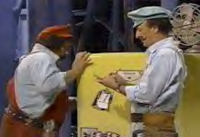
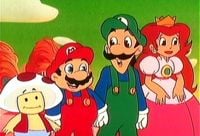
The Super Mario Bros. Super Show! shows both Mario and Luigi's lives in the real world and their lives in the Mushroom Kingdom, through both live-action and animated episodes. In the live-action portion of the show, Mario and Luigi are plumbers living in Brooklyn, working from Mario Bros. Plumbing, their basement workshop doubling as their home. They are shown as being financially unsuccessful, barely being able to get by; in some segments Mario is shown to have disdain for his life; in the episode "Baby Mario Love" Mario is shown complaining about his life being dull, not having any glitz or glamour.
In the animated segments, Mario and Luigi are traveling across the Mushroom Land with Toad and Princess Toadstool, searching for anyone or anything that can both rid the kingdom of King Koopa and send Mario and Luigi back home to Brooklyn. According to the first episode, "The Bird! The Bird!", they begin their quest shortly after Mario and Luigi have saved Princess Toadstool after arriving in the Mushroom Kingdom.
The live-action Mario was portrayed by professional WWE wrestler,Captain Lou Albano
The Adventures of Super Mario Bros. 3
Template:Appeared The Adventures of Super Mario Bros. 3 follows after the events of The Super Mario Bros. Super Show! This series of episodes are based on Super Mario Bros. 3. Unlike in the previous series, this one has Mushroom Kingdom in a more peaceful state. Mario has more enemies to fight, most notably, the Koopalings. The only episode Mario does not appear in is Life's Ruff.
Super Mario World
Template:Appeared The Super Mario World television series is a continuation of the previous series, The Adventures of Super Mario Bros. 3. This time, the episodes focuses loosely on the video game Super Mario World with added characters, the most prominent, Yoshi, the Cave People and Oogtar. Mario appears in every episode of the Super Mario World television series as one of the main protagonists.
Super Mario World: Mario to Yoshi no Bōken Land
Mario is one of the main characters in the interactive OVA Super Mario World: Mario to Yoshi no Bōken Land. The video follows the story of Super Mario World rather closely, though it is quite condensed. Mario leads a group on a quest to save Princess Peach from King Koopa. He is shown to be the bravest of the group, with Luigi and Yoshi less so. He often calls the viewer to ask questions.
Dr. Mario series
- Main article: Dr. Mario
Mario takes in a different alias in the first game of the puzzle subseries, Dr. Mario. Mario works alongside Nurse Toadstool (Princess Peach) at Mushroom Kingdom Hospital to combat three types of viruses: Fever, Chill and Weird. Here, he must drop Megavitamins to destroy these viruses.
Dr. Mario 64 features a story behind the gameplay. During a flu outbreak, Dr. Mario attempts to use his Megavitamins to heal the citizens. Wario, however, steals the Megavitamins and wishes to profit from them. Mad Scienstein intervenes and takes the Megavitamins, so after Dr. Mario beats Wario, the two follow Mad Scienstein, defeating enemies from Wario Land 3. Mad Scienstein then reveals himself to be a worker for Rudy the Clown, who is afflicted with the cold. Dr. Mario proceeds to cure Rudy after beating him, though. If Dr. Mario has not lost any matches, however, Wario takes the Megavitamins and transforms to Vampire Wario. Or, if the player is using Wario, Dr. Mario becomes Metal Mario after ingesting the pills.
Dr. Mario Online Rx has similar gameplay to the original Dr. Mario, although there is an additional Virus Buster minigame. Dr. Mario Express is similar to Dr. Mario Online Rx, but features no Virus Buster minigame.
Amada Anime Series: Super Mario Bros.
The Amada Anime Series: Super Mario Bros. series of Japan-only anime features Mario characters in classic fairy tale settings. Mario plays as the main protagonist, defeating Bowser in all of them.
Super Mario Momotarō
Super Mario Momotarō retells a popular Japanese folklore Momotarō, with Mario playing the role as the main hero. Bowser and the Koopalings have stolen Princess Peach from Ojīsan and Obāsan, two elderly Hammer Bros.. Eventually, the Hammer Bros. discover a shooting star in the form of a peach that has landed in their feet. Mario, as a mustached child, emerges from this peach and the two elderly Hammer Bros. welcome him into their family. While Mario rapidly grows up, Ojīsan and Obāsan accidentally mention Princess Peach. They explain their loss to Mario once Mario asks them for more information. Mario then ultimately decides to rescue her, even though Ojīsan is unwilling to let him go. The Hammer Bros. finally relent and they give aid to Mario for his journey, including a lunchbox with Mushrooms and a gun, a valuable family heirloom.
During his travels, Mario encounters a weak, starving Para-Beetle. He immediately befriends her by sharing his mushroom and she agrees to join his cause. Mario also helps a Boomerang Bro. up, who also joins Mario. Mario then finally befriends a Spike after the Spike has seen Bowser destroy his homeland. The four ride a rocket-powered Airship to confront Bowser and the Koopalings. While Mario's friends battle the Koopalings, Mario faces Bowser and, with help from the Para-Beetle and the Boomerang Bro., eventually defeats him. After winning the fight, Mario threatens Bowser at gunpoint until Bowser relents and agrees to stop destroying the lands and to return everything he has stolen, including Princess Peach. Princess Peach thanks Mario and his friends for rescuing her and they use the airship to return to Ojīsan and Obāsan.
Super Mario Issun-bōshi
Mario plays the role of the small hero in Super Mario Issun-bōshi, based on the Japanese folk tale Issun-bōshi. A couple has wished for a child, but while the shooting star delivers the child, who is Mario, he is only one inch tall. As Mario grows older, he notices a city beyond the mountains and wishes to travel there. His parents are reluctant at first, but they do not wish to shelter for the rest of his life. Mario's father gives him a sewing needle for a sword, a bowl with rocket engines for a boat and an oar for a chopstick to help Mario travel. Mario encounters several enemies along the way including a Spiny Cheep Cheep, Para-Beetles, a Blooper Nanny, a Dry Bones and a Lakitu. The Lakitu, however, summons a storm and sinks Mario and his boat, making him unconscious.
When Mario wakes, he finds himself in the city and Princess Peach, normal sized, who has rescued him. Peach introduces herself and explains that she has found him unconscious on the shore of the river. Mario thanks her and tells her his desire to explore in the city. Peach, who likes him, wants Mario to stay with her and he agrees, riding on Peach's shoulders. As they are walking in the city, however, Bowser ambushes and attacks Peach, demanding her that she should marry him. Princess Peach strongly refuses and, before Bowser resorts to force, Mario challenges Bowser. Bowser does not take Mario seriously and tries to stomp him, but he dodges his steps. Bowser, however, finally grabs Mario and swallows him. While Bowser is trying to kidnap Peach, though, Mario attacks Bowser from the inside with his needle sword, which forces Bowser to cough out Mario. Mario then cuts off Bowser's horns and eyebrows, making Bowser flee while passersby laugh at him. After thanking Mario, Peach notices a magic wish-granting hammer, which Bowser has dropped, and she then fulfills Mario's wish to be a full-sized human. In the end, the two use a hovercraft to return to home.
Super Mario Shirayuki-hime
Super Mario Shirayuki-hime is the final story of the series, based on Snow White. Bowser, as Queen Koopa, is jealous that Princess Peach is declared fairest in the land according to the magic mirror. Queen Koopa orders the Koopalings, Roy, Wendy, Morton and Iggy, to destroy Princess Peach. Mario rescues her and flees to a house containing his friends, the seven dwarves, who are Toads. After Mario tells them what is happening, the Toads promise to protect her while Mario is away. Queen Koopa, meanwhile, tricks Peach into eating a poisoned apple and casts her into a deep sleep. When Mario returns and finds Peach in a deep sleep, the Toads apologize for their failure. Mario then retrieves a potion he has received from a goddess in a foreign land and revives Peach. After Peach explains that she has been given a poisoned apple, Mario concludes that it is Queen Koopa and wants to punish Queen Koopa. With Peach and the Toads following, Mario travels to Queen Koopa's castle and defeats the Goombas there. When he confronts Queen Koopa, the Koopalings attack him with a magical electric blast. The Toads help Mario by giving him a powerup that makes him grow large and knock away the Koopalings. After chasing Queen Koopa, Queen Koopa takes Princess Peach and holds a knife near her neck. Luigi, however, ambushes Queen Koopa and the brothers defeat her by throwing her against the magic mirror. Mario, Peach, Luigi and the Toads then happily leave the castle, concluding the story arc.
Mario Teaches Typing series
Mario helps children type in both Mario Teaches Typing and Mario Teaches Typing 2. By typing correctly, players enable the game to advance. Mario Teaches Typing 2, the sequel, has another story. Mario and Luigi find a Magical Typewriter. The note attached to it explains that it is essential to beat Bowser. If one types the correct sequence into the scroll, a spell is cast and defeats Bowser. If it is used incorrectly, however, the typewriter will self-destruct. Mario attempts to type, but he fails and the typewriter explodes, sending its pieces to various regions. The two adventure, retrieving the pieces while improving their typing abilities, eventually restore the typewrite and cause a giant typewriter to fall on top of Bowser's castle.
Super Mario Bros. & Friends: When I Grow Up
Mario appears in various scenes of the virtual coloring book, Super Mario Bros. & Friends: When I Grow Up. He and various other Mario characters (and Link) are shown in various occupations.
Mario is Missing!
The 1992 game Mario is Missing! was the first game in the Mario Discovery Series[10] of Educational Games and set the Mario characters in Earth. When hearing of Bowser's plan to flood the Earth by melting Antarctica's ice with hair dryers, Mario, Luigi and Yoshi head to Bowser's castle in the Antarctic. Mario is captured, although his capture varies between versions of the game.
In the DOS version, Mario enters the castle alone, as Luigi is too scared to follow. Mario meets Bowser, who is in a butler disguise and accepts candy from him, despite Luigi's warning not to take candy from strangers. Bowser uses this as a distraction to trap Mario in a net. Despite his captured status, however, Mario in that version will nonetheless manage to give contact to Luigi to guide him to the continents to stop Bowser's plans, as well as update him on the situation. Over the course of the game, Mario tells Luigi that he admitted to Bowser that he has a fear of the dark, which strained communication since Bowser is threatening him with his fear. In the NES version, Mario is captured outside in the snow by a Koopa with a bag. In that version, he also reacts angrily to the title shortly before being captured by the Koopa. In the SNES version, Mario traps into a pitfall outside the castle.
The game centers around Luigi, who rescues Mario from Bowser in the end.
Super Mario-Kun
Mario has played a starring role on a long-running manga series, Super Mario-Kun. As the title implies ("kun" is a Japanese honorific for little boys), Mario is depicted as playful, brave and devoted to his friends, although immature, rash and sometimes mischievous. As the manga series is based on the games, Mario often plays the same role as he did in the games. The manga volumes typically depict Mario along with Yoshi or Luigi, although he sometimes befriends other partners to aid him. There are some major alterations in some portrayals, however, such as the Donkey Kong Country arc, where Mario does make an appearance, or in Super Mario World 2: Yoshi's Island, where Mario and Luigi's adult selves aid Yoshi and Baby Mario to save Baby Luigi.
Yoshi series
Yoshi
Mario is featured in the first game of the Yoshi series, entitled simply Yoshi (or Mario & Yoshi). The gameplay is similar to Tetris: Mario holds several enemies and must align them vertically to eliminate them and score points. Mario can also match egg halves vertically (even with enemies in between) to create a Yoshi's Egg that hatches a Baby Yoshi, giving Mario fifty points. The Yoshi Mario can hatch is dependent on the enemies between the egg halves.
Yoshi's Cookie
Mario is portrayed as a baker in another puzzle game of the Yoshi series, Yoshi's Cookie, along with and its remake in Nintendo Puzzle Collection. The title screen of the NES and Game Boy versions show a small narrative: Mario fails to open a cookie jar, but when he gets an idea and leaves, Yoshi enters and eats the jar. Mario then chases Yoshi with a hammer. When Mario returns with the cookie jar, however, the jar is empty. In the gameplay, Mario must clear rows and columns of cookies by matching them. There are six types of cookies he must match. Mario can also face against Princess Peach, Yoshi, or Bowser in the VS mode of the game, where he must maintain a higher lit fuse than his opponent by clearing rows of cookies. Matching five Yoshi Cookies gives a special move that can disrupt the opponent's playing field.
Yoshi's Safari
InYoshi's Safari, Mario and Yoshi are sent by Princess Peach to rescue Jewelry Land from Bowser's occupation. In this game, Mario uses a gun called the Super Scope (controlled by the player with said accessory for the Super Nintendo) to shoot enemies while riding on Yoshi's back. Mario fights the Koopalings and Bowser to free King Fret and Prince Pine of Jewelry Land.
Super Mario World 2: Yoshi's Island
- Main article: Baby Mario
Super Mario World 2: Yoshi's Island tells the story of Mario shortly after his birth. At the beginning of the game, the Stork is delivering newborn Baby Mario and Baby Luigi to their parents, but Kamek, predicting that the brothers will cause problems for Bowser in the future, attempts to capture the stork and babies, but captures only Luigi and the stork. Mario, despite being safe from Kamek, starts to fall, eventually landing on a nearby island, on the back of Yoshi. Yoshi then brings Baby Mario back to his village, where they decide to help Baby Mario in saving his brother.
During the game, Baby Mario rides on Yoshi's back. When Yoshi is hit, Baby Mario falls off and is trapped into a bubble. If the Yoshi does not catch the bubble in a short period of time, Baby Mario is kidnapped by Toadies. In that case, the level has to be restarted. Baby Mario can also run when Yoshi collects a Super Star, which transforms Baby Mario into Super Baby Mario for a short time.
At the end of the game, after Kamek and Baby Bowser's defeat and Baby Luigi's rescue, Baby Mario and Baby Luigi are brought to their mother and father.
Yoshi Touch & Go
Yoshi Touch & Go, unlike other Yoshi games, has no story. Each level in this game begins with Baby Mario with balloons, falling. The player must guide him with clouds while destroying obstacles with bubbles. Soon, Baby Mario lands on a Yoshi's back and Yoshi finishes the rest of the level.
Yoshi's Island DS
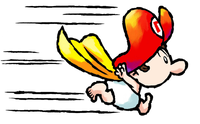
Kamek and his Toadies, searching for all of the Star Children, kidnap several babies in Yoshi's Island DS. The stars these children contain, Kamek has learned, are apparently powerful enough to control the universe. Baby Mario and Baby Luigi, later revealed to be Star Children, are one of the many babies that the Toadies have attempted to kidnap. During the kidnapping, the Stork, however, attacks the Toady holding Baby Mario. As a result, the Toady drops Baby Mario, although the other Toadies successfully kidnap Baby Luigi. Yoshi and his friends later find Baby Mario and help rescue Baby Luigi. Baby Mario himself grants the Yoshi the ability to dash, which can be useful when Yoshi needs to outrun obstacles. Baby Mario and the Yoshis also find Baby Peach, Baby Donkey Kong, Baby Wario and Baby Bowser (also later revealed as Star Children) along the way as additional help for the Yoshis, each with their own traits. As they progress, Bowser travels from the future to assist his Koopa Troop of the past. The Yoshis are able to defeat him with the help of the babies and the storks help carry the Yoshis and the babies back to their respective homes.
Yoshi's New Island
- Main article: Mr. Pipe
Yoshi's New Island, taking place chronologically after Super Mario World 2: Yoshi's Island explains that the Stork has misplaced Baby Mario and Baby Luigi in the wrong family. Kamek and his Koopa Troop subsequently kidnap Baby Luigi, while Baby Mario adventures with Yoshi to track and rescue Baby Luigi. Throughout their adventure, however, the two encounter a live Warp Pipe named Mr. Pipe. He helps them by giving them needed items. After the credits roll, this Warp Pipe stops and an adult Mario emerges. He eventually vanishes, presumably going back to his own time period.
Mario Kart series
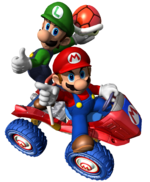
In the series of Mario Kart games, starting with Super Mario Kart, Mario has always been a playable character. In games where characters are divided into weight groups, Mario is always a middleweight character. Numerous tracks throughout the series have been called Mario Circuit, or something with the name "Mario" in it.
Mario appears in the Mario Kart series in the first installment: Super Mario Kart. Mario is average in all categories. When used by a computer, he sometimes uses star power, which gives him invincibility. Mario is used again for Mario Kart 64, where he is featured as a middleweight average-stats character. In Mario Kart: Super Circuit, Mario is once again used as middleweight characters with average speed and weight.
In Mario Kart: Double Dash!!, he is grouped with Luigi by default and their special item is the Fireball. His kart is the Red Fire, which is an all-around average kart. His baby version, Baby Mario, also makes his debut.
Mario once again returns as a character in Mario Kart DS. His karts are the B Dasher, the Standard MR and the Shooting Star. After beating the game, Mario can race in any of the karts. Mario later returns as a character for Mario Kart Wii. Unlike the previous installment, in Mario Kart Wii, Mario can ride on any of the medium Karts and Bikes. Mario also provides a small boost to handling, weight and acceleration on any vehicle he drives. Mario returns as a playable character in Mario Kart 7. Like in the previous titles, he is a medium class racer and most of his stat boosts are around average levels. Mario's metallic rival, Metal Mario, also makes his debut in the Mario Kart series.
In Mario Kart 8, Mario is yet again a middleweight, sharing this distinction with not just Luigi, but also Ludwig von Koopa and Iggy Koopa. His stats, however, are not perfectly balanced. His top speed and traction are his strongest stats while his acceleration is his weakest stats. If Mario drives certain vehicles, these vehicles will be colored red to match Mario's dominant color, the exceptions are the GLA and City Tripper. Unlike in Mario Kart Wii, Mario can ride on any vehicle in the game.
In Mario Kart Arcade GP, he is an all-around type and shares his special character items with Luigi. His special items are a star, which gives Mario invincibility; a fireball, which can be shot forward or backward to damage a kart; the hammer, which can hit a rival, giving them damage; and the Chain Chomp, which provides damage to any kart it hits. Mario then appeared in Mario Kart Arcade GP 2, the sequel to the original. Mario, as Luigi, Pac-Man and Waluigi, is an all-around racer. Mario reappears in Mario Kart Arcade GP DX as yet again a balanced middleweight character. His personal kart is the Lightning Champ. He also receives a Fire Mario alternate palette swap.
Mario Paint
Mario played a minor role in Mario Paint. He appears in the interactive title screen, although he also makes appearances for a few icons. In the game, players can paint, create sprites, create music and animate. Mario's icon during music mode indicates a piano-like instrument.
Mario's Time Machine
In Mario's Time Machine, Bowser uses a time machine to steal various artifacts from different time periods of human history in order to display them at his museum. Mario goes on a mission to return all objects of Bowser's museum to their original time periods in order to prevent history from being altered. Additionally, Mario had to rescue Yoshi from Bowser in the NES version of the game. Mario's Time Machine is one of the few games in which Mario talks.
In the NES version, the player has to play an altered version of Mario Bros. to defeat Koopa Troopas, who drop the stolen objects when defeated. Mario then has to travel back in time to return the objects to their proper place in a side-scrolling mission.
In the SNES version, Mario has to pick a stolen object from the museum and then go to a "Time Surfing" level to collect enough Mushrooms to make a time jump, then return the objects to their proper place.
Mario & Wario
In Mario & Wario, Mario is a passive character. Wario drops buckets or barrels or similar objects on his head, blinding him. The fairy Wanda has to guide Mario safely to Luigi through hazards and traps in each level. When arriving at the end of the level, Luigi will free Mario from the sight-blocking object. Mario is only one of the characters that have to be guided through levels by Wanda like this in the game. The other characters are Princess Peach and Yoshi. Mario walks at a medium speed, while Peach is slow and Yoshi is fast.
Mario's Early Years! series
Mario has appeared in Mario's Early Years! series, which consists of three games. Mario, by traveling to different worlds, teaches basic learning skills to younger players such as counting, recognizing shapes and basic spelling. Mario is controlled by a cursor interacting with an object.
Mario's Picross series
Mario is featured as an archaeologist in Mario's Picross. Mario Picross is a puzzle game where Mario must scrape squares according to the numbered indicators on each column and row. Completing the puzzle correctly usually shows an image, sometimes referring to earlier games in the Mario series. During the gameplay, Mario is also given hints such as an entire row being scraped correctly or a roulette that determines which lines are revealed. Mario reappears in the sequel, Picross 2, where now, he must match boxes and link them to form specific images. Mario again appears in Mario's Super Picross, on the Super Famicom. As in Picross 2, Wario also appears in it. Mario is given a set of rules, where he works under a time limit and gets penalized if he makes a mistake. Wario, on the other hand, has no time limit, but mistakes are not apparent and no hints are given.
Hotel Mario
In Hotel Mario, Mario and Luigi travel to the Mushroom Kingdom after an invitation for a picnic by Princess Peach. Upon arriving, the two find out that Peach has been kidnapped by Bowser, who has made her a "permanent guest" in one of his seven Koopa Hotels. Mario and Luigi travel from one Koopaling's hotel to the next, with Peach being brought to a new hotel every time the brothers have searched through the last one. After destroying most of the Koopaling hotels, Mario fights Bowser in his own hotel and defeats him. He then receives a kiss from Princess Peach, then congratulates the player as 'The best ever'.
In the game, Mario has to close all doors in a hotel in order to proceed. Mario can stomp on enemies to defeat them, similar to the Super Mario series. He can also hide in open doors and take elevators to change his level. On a side note, Mario has four fingers instead of the normal five in this game.
Mario's FUNdamentals
Mario has also appeared in Mario's FUNdamentals. Here, Mario plays several games with younger players such as "Go Fish", "Checkers", "Backgammon", "Dominoes", or "Yahtzee." This game is also the first game where Charles Martinet, the current voice actor for Mario, provided voices for Mario.
Mario Tennis series
Mario is a playable character in all games of the Mario Tennis series. In all games in the series - Mario Tennis for the Nintendo 64, Mario Power Tennis for the Nintendo GameCube, Mario Tennis: Power Tour for the Game Boy Advance and Mario Tennis Open for the Nintendo 3DS - he is an all-around character. In Mario Tennis for the Game Boy Color, Mario is an unlockable character and can be unlocked by completing the Singles Mario Tour.
In the intro for the game Mario Tennis for the Nintendo 64, Mario is one of the participants of the tournament. Here, he defeats Donkey Kong to gain access to the semi-finals. In the semi-finals, he defeats Yoshi and moves on to the grand final against Luigi. While the two brothers are looking for the missing tennis ball prior to the match, Wario and his partner Waluigi appear and cause mischief. After this, Bowser and a Boo appear. Everyone, thinking that they are there also to cause trouble, stand back in fear. However, Bowser and Boo reveal that they simply want to play a nice game of tennis, to which Mario exclaims "let's all play!", which is met with cheering and agreement. Initially unknown to the cast however, a Bob-omb walks on to the court and explodes.
In Mario Power Tennis, Mario and Luigi are the only all-around characters. Unlike in other games, Mario and Luigi have subtle differences within each other. While they have nearly identical movement speed, Mario has more power while Luigi has slightly more reach and more control. Mario, when compared to other characters, has a slightly below-average reach and lunge because of his short stature. Mario is stronger than most non-power characters. All his other stats are average. Mario's Offensive Power Shot has his racket transform into a giant mallet, which enables him to hit the ball with high speed and force; opponents that return the ball may get blasted to the back of the court. Mario's Defensive Power Shot is a simple spin that allows him to reach lobs and faraway balls quickly, but it is one of the few Defensive Power Shots that fail when the ball is too far away. Mario's taunt is him waving and saying "Come on!".
Mario has appeared occasionally in several trophy-earning cutscenes in Mario Power Tennis. While Mario has appeared more than most characters in these cutscenes, Luigi appears in most trophy-earning cutscenes.
In Mario Tennis Open, Mario shares nearly identical stats from Mario Power Tennis. Mario's metal form, Metal Mario, also appears as a Power character. Miis in the game can also wear tennis attire with Mario's colors and emblem. Miis can even wear the Mario costume, Mario's attire, after the player beats the Star Tournament in Singles.
Mario appears in Mario Tennis: Ultra Smash as again an All-Around character. His tennis racket color is slightly different in this game; rather than being a solid blue, Mario's racket is predominantly red and blue with some white.
Mario Clash
Mario shoots at Koopas and various other enemies in Mario Clash, a game for the Virtual Boy. Mario has to knock enemies away with Koopa Shells at the side. The game's gameplay is similar to the style of Mario Bros., but Luigi is absent.
Super Mario RPG: Legend of the Seven Stars
Mario appears as the main protagonist in Super Mario RPG: Legend of the Seven Stars. Mario first arrives to confront Bowser who has again captured Princess Peach (which by now is a recurring event). Mario battles Bowser atop a Kinklink and rescues Peach. Then a huge sword, Exor, strikes the castle from atop and knocks them all to various spots in the Mushroom Kingdom. Mario falls through the Pipe on top of his house and lands on his bed.
Mario discovers that the Star Pieces that grants dreams are stolen by a group called the Smithy Gang runned by Smithy. They have not only stolen the Star Shards, but have also caused trouble to the Mushroom Kingdom. On this adventure, Mario recruits Mallow, Geno, Princess Peach and even Bowser. They travel through much of the Mushroom Kingdom finding Star Shards, which are protected by the Smithy Gang's strongest members. After all Star Shards are collected, Mario fights Smithy. Mario reaches it through Bowser's Keep, which is inaccessible when Exor destroyed the bridge. With the help of Mallow's parents, King and Queen Nimbus, Mario has passage through a special cloud bus. When they finally arrived, Mario defeats Exor and goes to Smithy's dimension via Exor's mouth.
Mario's journey is not over since Smithy has even more minions at his disposal. After many battles, Mario faces and defeats Smithy, saving the Mushroom Kingdom.
Mario Party series
Mario is one of the playable characters in Mario Party series. He is always represented by his trademark red color. Mario can compete in minigames to win coins (or Mini Stars, in Mario Party 9 and in Star-Crossed Skyway in Mario Party: Island Tour), which ultimately can help him earn Stars. In the first three Mario Party games, Mario aims to become the superstar, the character with the most Stars, coins being the tiebreaker. Though Mario has no distinguishable traits from the other Mario Party characters, the most notable difference is Mario's ability to use the Fireball Orb in Mario Party 7. Additionally, Mario's default Duel Mode partner is Koopa Troopa in Mario Party 3 and the booklet says that his favorite item is the Golden Mushroom, which increases the likelihood of his purchasing one if he is CPU-controlled. In Mario Party 3, he also challenges the player for the Courage Star Stamp if he is not used.
Super Smash Bros. series
Template:SSB Infobox Mario has been playable in every Super Smash Bros. game to date. Mario is usually portrayed as a "main" character alongside Link, Kirby and Pikachu. Mario has retained his balanced abilities even when fighting characters from other series. Due to his balanced playstyle, Mario's skill is reflected by the player, as mentioned by the Adventure mode Mario trophy. Also as a result of his balanced design, Mario is also typically chosen for the "template" character; in Super Smash Bros. Brawl players use him when testing changes in Stage Creator and in Super Smash Bros. for Nintendo 3DS / Wii U, his silhouette is an opponent character for special move demonstrations. He is also used for controller mapping testing and is part of the gauge when players select the level of intensity in Classic Mode. Mario's moveset consists of quick short-ranged attacks such as punches, kicks and even head attacks.
Mario's special moves are Fireball, a bouncing fireball, Cape, a cape swipe that reflects projectiles, Super Jump Punch, which has him jump and coins fly out when in contact with enemies, Mario Tornado, which has him spinning rapidly (since Super Smash Bros. Brawl, it was replaced by F.L.U.D.D., a machine sprays water which can push opponents). His Final Smash is Mario Finale, which consists him unleashing a two-streamed blast of fire.
In Super Smash Bros. for Nintendo 3DS / Wii U, Mario, as any character, can use equipment to boost his stats at the cost of others. In addition to generic badges, Mario can wear certain additional equipment including shoes (speed), overalls (defense) and gloves (attack). Finally, Mario can use alternate special moves, provided that these moves are found during normal gameplay. One exception, in the Nintendo 3DS version, the Explosive Punch, which is unlocked only if the player has a combined score of 200000 points in Target Blast and the third Challenge Panel has been revealed.
Mario's alter-egos Dr. Mario and Metal Mario have also made appearances, with Dr. Mario being playable twice, in Super Smash Bros. Melee and Super Smash Bros. for Nintendo 3DS / Wii U. Mario made also additional trophy and sticker appearances such as his Strikers incarnation, his Raccoon form and him driving a vehicle.
Role in the Subspace Emissary
In the beginning, a trophy of Mario and Kirby are thrown into an arena. The two come to life and fight. The player chooses the one to play with. If Mario is chosen, the opponent will be Kirby. After the battle between the two, Mario resurrects Kirby. This scenario happens the other way around if the player chooses Kirby instead. The Subspace Army then ambushes the two. Peach and Zelda come to help and they are all confronted by the Ancient Minister. After seeing the two R.O.B.s setting up a Subspace Bomb, Mario runs to try and stop it, only to be blasted away by Petey Piranha. Afterwards, he meets Pit after the latter has descended from Skyworld. They team up and reach land and give chase to the Ancient Minister, but they lose him.
Eventually, Mario sees Peach's trophy form apparently dissolving. Thinking Link and Yoshi have done this, Mario and Pit attack them, only to be defeated and stolen by King Dedede. Kirby, however, saves them both and Pit shoots an arrow at the Cargo that Dedede was driving, blowing its engine out. Keep note that this only happens if Peach was rescued from Petey Piranha.
If Zelda is rescued, Mario and Pit end up facing a False Zelda, with Pit destroying her Dark Cannon that she was about to fire at Link and Yoshi. Link sees the Zelda trophy dissolve and he and Yoshi attack Mario and Pit. Mario and Pit defeat them, but Mario sees the Peach trophy in the Cargo before Dedede takes Yoshi and Link. When Kirby saves them, Link is the one that blows out the engine.
Regardless, Mario and his team chase Dedede through a cave and into his castle, only to find his throne room a mess and himself and the trophies he had nowhere to be found. They go through a secret passage and see Bowser trying to get away. Mario attacks, only to find that he has the princess not rescued from Petey Piranha. Pit fires an arrow, but Bowser dodges and the badge that the princess was wearing falls. Bowser gets away and Kirby eats the badge.
Mario and his team encounter the Ancient Minister again later and chase him through the Wilds, but the R.O.B.s stop them and detonate the Subspace Bomb that the Ancient Minister was carrying. Mario and his team escape and end up fighting the Subspace Army at the Canyon where they meet the Ice Climbers, Marth, Lucas, the Pokémon Trainer and Ike. For the rest of the adventure, Mario fights with his increasing group until he and his allies defeat Tabuu and restore the world to normal.
Paper Mario series
Paper Mario
Mario once again is invited to a party in Princess Peach's Castle in Paper Mario. Bowser interrupts, uprooting the castle and lifting it into the air. He and Kammy Koopa use the power of the Star Rod and defeat Mario. Bowser then tosses Mario out the castle. Mario lands in a small forest located on the outskirts of Goomba Village. Mario befriends Goombario, his first partner, and heads to Toad Town via Goomba Road.
Mario hears a Star Spirit called Eldstar asking for his help. The Star Spirit requests that he speak to him on Shooting Star Summit, in which he has more strength to speak better. Once there, Mario meets many other Star Spirits asking for his help. He learns that Bowser had imprisoned them in special cards and has given them to his strongest minions. Mario then sets out on a quest in search of the Star Spirits. Mario makes many new friends and partners, eventually collecting all seven Star Spirits. Mario returns to Shooting Star Summit where he gains access to Star Way. Mario acquires a new ability called Star Beam and is transported to Bowser's Castle from the Star Shrine. While Mario and his team are at Bowser's Castle, they save the many captives and fight Bowser at the top of the castle.
Bowser breaks the bridge Mario came from, ensuring that Mario cannot escape and uses his Star Rod to fight. Mario, knowing the Star Rod's counter this time, uses Star Beam to weaken his power. The reluctant Bowser is unaffected by it and shakes the beam's power off. Watching the team's losing, Peach and Twink fight Kammy, who's responsible for creating the Power Platform that strengthens Bowser's Star Rod. They defeat Kammy and teach the Peach Beam while fully restoring Mario's party. Mario and company use the Peach Beam at Bowser the penetrate the Star Rod's shield, leaving him open to attack. Mario and his friends eventually defeat Bowser and once again, save the Mushroom Kingdom. The castle returns to ground from where it came from and another party is held there later while the power of wishes is restored. After a parade led by Luigi, Mario takes Peach to his house,where they watch the fireworks.
During the events of this game, Toad Town News traces Mario as he tries to save the Star Spirits and posts news about his progress.
Tattle
When Mario and his partner are battling in the dojo, Lee may transform into Goombario and use his tattle ability in battle.
- “It's Mario, silly! He's here to save Princess Peach, who was kidnapped by Bowser. Remember? He fights until the bitter end, no matter what enemies attack.”
- —Lee, Paper Mario
Paper Mario: The Thousand-Year Door
Peach invites Mario to Rogueport in Paper Mario: The Thousand-Year Door to share a treasure map leading to powerful artifacts called Crystal Stars. By the time Mario arrives, the X-Nauts have kidnapped her. The X-Nauts need to use her as a vessel for the Shadow Queen so the leader of the X-Nauts, Sir Grodus, can use her power to aid him in world domination.
Mario meets Professor Frankly, who tells him the history of Rogueport and reveals the secret of The Thousand-Year Door. The Shadow Queen has once controlled Rogueport and trapped many of its citizens after Crystal Stars granted her power. The Four Legendary Heroes have used the power of the Crystal Stars against her imprisoned her in the Thousand Year Door for a millennium. After learning this story, Mario sets out to collect all seven Crystal Stars. Gaining many new partners and finding all Crystal Stars, Mario enters the Thousand Year Door. There he finds Sir Grodus standing before the Shadow Queen's room. Mario defeats Sir Grodus, but is then ambushed by Bowser and Kammy Koopa. This gives Grodus time to escape with Peach to the Shadow Queen's room. When Mario arrives, Grodus has awakened the Shadow Queen herself, taking control of Peach's body. Mario has to fight her possessed form and using the help of the Rogueport citizens' wishes, Mario prevails.
In the Glitz Pit, Mario and his partner's team is named "The Great Gonzales" (in Japanese: 『じごくかちまた しょけいにん』グレート・ゴンザレス) by Grubba. Additionally in the Glitz Pit, when Mario optionally returns to the Glitz Pit to fight Rawk Hawk a second time, someone in the crowd yells, "Jumpman! Wait. Who?", referencing to Mario's original name in Donkey Kong.
Super Paper Mario
Mario and Luigi are once again called into action in Super Paper Mario. Mario and Luigi sit in their house one day when they hear the news that Princess Peach has been kidnapped. The Mario Bros. rush to Bowser's Castle, thinking he has the princess, an assumption to be proven wrong. Later, a new antagonist named Count Bleck shows up and kidnaps Luigi and Bowser. It is also revealed that Count Bleck has Princess Peach, too.
Mario is transported to Flipside, a town between dimensions. Mario later finds Bowser and Princess Peach who decide to join with Mario in his quest to stop Count Bleck. Mario must go through eight chapters to get eight Pure Hearts, which can counter the Chaos Heart. Mario also encounters new enemies such as O'Chunks, Dimentio, Mimi, Nastasia and even his brother Luigi, now called Mr. L because Nastasia, an assistant of Count Bleck, has brainwashed him (however, he joined Mario once he is freed by Dimentio and sent to The Underwhere).
After collecting the eight Pure Hearts, Mario, Princess Peach, Bowser, Luigi and some Pixls face Count Bleck. After defeating Bleck, Dimentio, a former minion of Bleck, betrays Bleck and teleports him to Dimension D to deal with him later. Then Dimentio, the Chaos Heart and Luigi merge together to form Super Dimentio as the final boss. After Mario has defeated Super Dimentio, Count Bleck and Tippi get married to stop the Void. Mario is mentioned to be the first of the Heroes of Light.
Paper Mario: Sticker Star
In the fourth installment of the Paper Mario series, Mario, along with Princess Peach and many Toads, is celebrating Sticker Fest, a holiday where six Royal Stickers ride in on a comet and it allows wishes to come true. Bowser, however, takes the comet for himself, releasing its Royal Stickers to him and his minions. Mario attempts to jump on him, but his efforts fail and Mario is knocked out. Shortly after waking up, he meets a sticker guardian named Kersti and with her help, saves some Toads hidden around the town and takes back the Royal Stickers. Mario then pursues Bowser by traveling through various worlds. Along the way, Mario must collect various stickers to aid him in defeating enemies and progress through levels.
After getting five of the six Royal Stickers, Mario is allowed to enter Bowser's castle. Bowser is defeated by Mario and he gets the last Royal Sticker, but Kersti is destroyed in the process. He releases Peach, who thanks Mario for his efforts and allows him to make a wish on the Sticker Star. He wishes for the return of Kersti and the Sticker Fest is saved.
Luigi's Mansion series
Luigi's Mansion
Mario plays his third role as a captive during the events of Luigi's Mansion. Mario visits a mansion that Luigi has mysteriously won. There, King Boo overpowers Mario with his many Boos and imprisons him within a portrait. King Boo is apparently mad at Mario for harassing his kind during his past adventures. Luigi comes later to discover why his brother did not come back. Luigi overcomes his cowardice and captures all Boos using his Poltergust 3000. After defeating King Boo, Luigi takes Mario's portrait and reverts him to his original form using Professor Elvin Gadd's Ghost Portrificationizer in reverse. Mario is left dizzy in the picture frame while Luigi laughs at him.
Luigi's Mansion: Dark Moon
While Mario reappears in Luigi's Mansion: Dark Moon, he plays a relatively minor role in the game. Prior to the final boss battle, Mario is found trapped as a sketch in a painting again. Mario is not directly referenced or seen until in Haunted Towers, where Luigi sees the Boos holding an upside-down portrait of his being trapped. There, only his feet are showing. Later, King Boo reveals that he trapped him and engages Luigi in battle. After King Boo is defeated, Luigi frees Mario with his Dark-Light Device, after which he, Mario, E. Gadd, several ghosts and several Toads pose for a picture.
WarioWare series
Mario has made only minor, albeit occasional, appearances in the WarioWare series, being small cameos in some microgames. In WarioWare: Mega Microgame$, Mario is the "judge" in the microgame Ultra Machine. He and Bowser are also parodied in Classic Clash I, Classic Clash II and Classic Clash III. In WarioWare: Twisted, Wario must greet him in the microgame Burying the Hatchet. In WarioWare: Touched!, he appears as a blackboard drawing in Jimmy T.'s microgame Chalk Full. Mario also appears in Wario-Man's microgames You Scratch Mine, alongside Wario and even Toad. In Where's Wario, he appears alongside Luigi. Mario frequently appears in 9-Volt's classic microgames, like Super Mario Bros. and Super Mario Sunshine. In Game & Wario, one of the microgames in the Gamer minigame, Sole Man, involves Mario, in the third level of difficulty. Here, the player's character, dressed as a Goomba, must avoid getting stomped by him.
Mario & Luigi series
Mario & Luigi: Superstar Saga
Mario ventures with Luigi through Beanbean Kingdom in Mario & Luigi: Superstar Saga to stop Cackletta from taking over Beanbean Kingdom. An ambassador from the Beanbean Kingdom visits Princess Peach. However, the ambassador is actually Cackletta and she steals Princess Peach's voice during the visit. Toad runs to Mario's house, warning him about Princess Peach's voice dilemma. Mario rushes to the castle, dragging Luigi. There, Mario fights Bowser, but Peach speaks and interrupts their fight. As she speaks, explosives drop from her mouth and shake the castle. Bowser, outraged that another villain has stolen his spotlight, suggests that Mario and Luigi go to the Beanbean Kingdom with his Koopa Cruiser.
Cackletta's apprentice, Fawful causes the Koopa Cruiser to crash, causing Mario and Luigi to land on the Beanbean Borderlands while Bowser eventually ends up getting brainwashed by Popple and goes under the Rookie alias. Mario and Luigi frequently fight these two throughout their adventure. In the meantime, Mario and Luigi rescue Prince Peasley from Cackletta's spell in Hoohoo Mountain, who grants passage to Beanbean Castle. At the Beanbean Castle, however, Mario and Luigi are tricked into disabling the castle's security, allowing Cackletta and Fawful to steal the Beanstar. They learn that the Beanstar grants anyone that posses a pure voice, which is why Cackletta has stolen Princess Peach's voice. Meanwhile, Queen Bean has been infected with a Belly Blech worm and Mario and Luigi must retrieve the Chuckola Reserve at the Chateau de Chucklehuck for her to recover. Once Queen Bean is healed, they learn about Cackletta's hideout in Woohoo Hooniversity. Mario and Luigi confront Cackletta and Fawful, who attempt to use Peach-bots to awaken the Beanstar, but only enrages it. After Mario and Luigi defeat Cackletta, Prince Peasley knocks Fawful and Cackletta's life essence away. When the two attempt to retrieve the Beanstar, they fight Popple and Rookie, although a partially functioning Peach-bot enrages this Beanstar once more. With Mario, Luigi, Popple and Rookie hanging on (while Rookie realizes his true identity), they blast away from Woohoo Hooniversity, but the Beanstar shatters into four pieces. Mario and Luigi crash land at Oho Oasis, but they make their way back to the Beanbean mainland after Prince Peasley informs them of Peach's presence at the Beanbean International Airport.
Mario and Luigi arrive at the Beanbean International Airport, expecting Princess Peach. Clearing the Airport of a few Piranhas, the Toad Express lands on the runway. Mario and Luigi, surprised to see Princess Peach talking in her normal voice, ask how she has gotten her voice back. Princess Peach explains that the Peach that has her voice stolen is a decoy. After the Princess's visit, Princess Peach requests to go to Little Fungitown. Mario contracts Bean Fever after consuming an Invincishroom, but when Luigi is about to cure Mario, Bowletta appears and kidnaps Princess Peach. Bowletta is Cackletta's possessing Bowser's body; Fawful has inserted Cackletta's life essence into Bowser after the fight at Woohoo Hooniversity. At Beanbean Castle, Mario and Luigi hear from Bowletta that the Beanstar has been scattered. Mario and Luigi then travel to find the four scattered Beanstar Pieces in Gwarhar Lagoon, from Harhall, at the Yoshi Theater and at the Winkle Colosseum. After receiving all four pieces, they return to the castle, where Bowletta again sends a message to deliver the restored Beanstar to Joke's End, with Peach in return. At Joke's End, they save Peach by disguising Luigi as her. Bowletta discovers this in her somehow-repaired Koopa Cruiser, but Luigi manages to escape safely.
Despite this, Bowletta also takes over Bowser's Castle and attacks the Beanbean Castle Town. Mario and Luigi ask Blanbladon to take them to the Bowser's Castle. After defeating many Koopalings and strong enemies and eventually Fawful. When they defeat Bowletta at the throne room, she sucks them into her body where they have to fight Cackletta's Spirit. Mario and Luigi finally destroy Cackletta and her spirit. They escape from the castle (which is set to explode) in time, saving the Beanbean Kingdom.
Mario & Luigi: Partners in Time
Mario and his brother Luigi travel back in time in Mario & Luigi: Partners in Time. Mario and Luigi are at Princess Peach's Castle, watching Princess Peach go to the past using Professor E. Gadd's Time Machine powered by the Cobalt Star. A few minutes later, however, the Time Machine returns, but without Princess Peach. A Junior Shrooboid attacks Mario and Luigi. They manage to beat it, allowing E. Gadd study it. Afterward, a Time Hole appears in the center court of the castle.
Mario and Luigi look at it in awe, when Toadsworth comes and accidentally knocks Luigi into the Time Hole. Mario enters it to save Luigi and they travel back in time. They land on the starting road to Hollijolli Village, fighting more and more enemies. They see the village damaged and ruined by many Shroobs and Shroob UFOs. They then get assaulted and nearly defeated by a wave of Shroobs and Shroob UFOs. Meanwhile, Baby Mario and Baby Luigi rescues them by defeating the remaining Shroob foes.
Baby Bowser helps them escape from Baby Peach's incessant crying. They board his Koopa Cruiser and crash landed into Bowser's Castle as a result of the Shroob UFOs aerial attacks. Mario and Luigi look for their younger selves and head for Baby Bowser's room. There, a Time Hole is located and the four Mario Bros. head back to the Princess Peach's Castle of the present. Professor E. Gadd speaks to them and advises that they go find pieces of the Cobalt Star Shards.
Mario and the others notice the new Time Holes that appear around the castle. They meet Toadiko and Toadbert who tell them about the Shroobs and the Princess Shroob. They finally collect all five Cobalt Star Shards and break the barrier of the Shroob Castle (previously Princess Peach's Castle) and go for the Shroob Princess. The Mario Bros. defeat the Shroob Princess and even the Elder Princess Shroob and prevail. Professor E. Gadd discovers that the chemical makeup of the babies' tears can revert all of the Shroob's Shroobification. Thus, all the victims of the Shroobs are saved by the four Mario brothers.
Mario & Luigi: Bowser's Inside Story
Mario and Luigi appear again in Mario & Luigi: Bowser's Inside Story. A new disease, the Blorbs, which make Toads grow to a giant size, has affected the Mushroom Kindgom citizens from Fawful, who is selling Blorb Mushrooms. Mario and Luigi attend a meeting that is disrupted when Bowser barges in. Bowser then fights Mario. After defeated, Bowser receives a Vacuum Mushroom from Fawful. The mushroom makes Bowser inhale everything, including Mario, Luigi, Starlow and the Princess.
Mario and Luigi are found inside Bowser, who is knocked out in Cavi Cape. The Bros. and Starlow help Bowser get his castle back from Fawful. Along the way, Bowser meets Broque and Broggy and gets the ability of the Vacuum block. Mario, Luigi and Starlow aids Bowser in his trips, while they travel to various parts of his body. When Bowser finally reaches his castle and reclaims it, Bowser is grown fat from eating high-calorie foods from the Boos after winning the fight against Midbus, a giant pig armadillo hybrid.
While Bowser is fat, Mario and Luigi find Peach in the Flab Zone, who is attacked and kidnapped in front of them by Alpha Kretin. After a long chase, Mario and Luigi trap and defeat Alpha and Beta Kretin, freeing the Princess. Peach, after the boss battle, tells them that Fawful probably wants the Dark Star, so he can control the Mushroom Kingdom. She also explains that Peach herself is necessary for this process. As they get to the end of the Flab Zone, Peach is taken out of Bowser's Body by Fawful and is once again kidnapped. Meanwhile, Midbus gives Bowser a treadmill to lose his extra pounds on.
As the rest of the adventure slides, Mario and Luigi travel until they find Bowser knocked out in a island of trash. After fighting Junker, they go back into Bowser and wake him up from his back pain. After going through the castle all to finding the Dark Star awakening and Fawful becoming Dark Fawful, who is sent flying by Bowser. Dark Star enters Bowser, who copies his DNA, but is incomplete thanks to the Mario Bros. and combines with Dark Fawful to create Dark Bowser.
After Mario and Luigi defeat Dark Star Core and Bowser defeats Dark Bowser, Fawful explodes, destroying himself and expelling everyone else from Bowser's body, freeing them. After realizing that the Mario's were inside Bowser, Bowser and Mario & Luigi fight, which ends the story. At the end, it is revealed that Mario and Luigi win yet again and Bowser is back at his ruined castle, recovering from the injuries he sustained in their fight.
Mario & Luigi: Dream Team
It has been requested that this section be rewritten and expanded to include more information.
Mario reappears along with Luigi in the fourth installment of the Mario & Luigi series, Mario & Luigi: Dream Team, where he, his brother, Princess Peach, Toadsworth and the Toads are invited to Pi'illo Island by Dr. Snoozemore through a message that was delivered by his Broggy. Mario & Luigi follow the two through the ruins and find Peach and Toadsworth surrounded by a group of Smoldergeist, which flee when the Bros. arrive. Here they find a Pi'illo, which later turns out to be Prince Dreambert. This action causes the Smoldergeist to come back and attack the Bros.. After beating the group and leaving the ruins, the Bros. come to a collection room. Here Luigi takes a nap on the pillow. After everyone gathers in the collection room, a Dream Portal opens a portal to a place called the Dream World. This allows Antasma, unknown by anyone, to pull Princess Peach into the world against her will. After Mario chases after Peach into Dreamy Pi'illo Castle, with the help of Dreamy Broque Monsieur, he meets Dreamy Luigi, Luigi's dream representation, who assists Mario in the Dream World. Later in the game, it is revealed that while Luigi can open a portal to the Dream World, Mario cannot.
Mario & Luigi: Paper Jam
In the fifth installment of the Mario & Luigi series, Mario & Luigi: Paper Jam, Luigi accidentally releases the Paper Mario universe into the Mario & Luigi universe. Mario meets Paper Peach and agrees to work with her to find the Paper Toads that have spread across the the kingdom. However, Bowser teams up with his paper counterpart and kidnap both princesses. In Sunbeam Plains, Mario and Luigi find Paper Mario and learn the kidnappings of the princesses. Bowser sends Petey Piranha to attack the trio, but they defeat Petey. When Kamek blocks the exit of Sunbeam Plains with a Papercraft Goomba, Toadette builds Papercraft Mario to help destroy it. In Doop Doop Dunes where they spot Bowser's Castle in the distance. After defeating two Pokeys, they encounter Kamek and his latest Papercraft. Toadette builds another Papercraft that defeats the Kamek duo. Later in Bowser's Castle, Bowser defeats them, trapping them in a dungeon where they lose the book containing the Paper Mario world. They escape, however, retrieving their items and the trio return to Peach's Castle.
There, Paper Toads report they saw the princesses at Mount Brrr. After traversing Gloomy Woods to reach Mount Brrr, the trio encounters the Kamek duo and defeats them. After reaching Mount Brrr with Flutter's help, the trio encounters King Bob-omb and some of the Koopalings, who set enemies in their path. Despite this, they overcome the enemies and build Papercraft Peach that defeats Papercraft Bowser Jr.. However, the Bowser Jr.s escape with the princesses and the book unharmed. They leave a Red Medallion behind which opens the door to the Twinsy Tropic Dungeon, but the trio must travel through Doop Doop Dunes again. Before leaving the Dunes, they have to face the Chargin' Chuck Corps who arrested them earlier. After this, they battle with two of the Koopalings before reaching Bowser's Castle. At Bowser's Castle, they find the Kamek duo and the new Papercraft King Boo. Toadette arrives with Papercraft Yoshi who defeats Papercraft King Boo. This time however, Kamek kidnaps Toadette to prevent more Papercrafts from being built. Kamek then plans to build his own Papercraft Bowser with the help of his paper form. A Fly Guy helps the the trio rescue Toadette and the trio encounters the Bowser Jr.s on guard duty.
The princesses escape and greet the team, but are caught by Bowser Jr.. Before fighting, however, they realize they forgot to hide the book and then flee. The trio catches them and they receive a fake book which fools the trio, allowing the princesses to be recaptured. Despite this, the trio defeats them and rescues the princesses. In retaliation, the Koopa Troop blows up Peach's Castle. The princesses return to the castle and trio continue to fight Paper Bowser, knowing the princesses are safe. Toadette realizes they can build a staircase to the top of Mount Brrr, where the newly built Neo Bowser's Castle is located. They travel through the Gloomy Woods once again but end up on the haunted side. Both Marios are kidnapped by Boos, leaving Luigi alone to find them. Once Luigi has defeated King Boo and rescued them, they meet Toadette and the remaining Paper Toads at Mount Brrr. The Toads build a staircase and the trio climbs to the castle. Iggy signals the rest of the Koopalings that the team has arrived. They encounter Nabbit and help him collect the coins around the area, Nabbit rewards them with the remaining Bros. Attacks. They find Toadette, who is defending the Papercraft creations, but the Kamek duo unleashes Papercraft Bowser, who burns all the Papercraft. Toadette, however, uses fire ore to build Papercraft Fire Mario. The new Papercraft defeats the Papercraft Bowser. The Koopalings try to retaliate and set a timer to blow up any remains of Peach's Castle, but the Mario Bros. stop the timer. The trio face the Kamek duo and the Koopalings and promptly defeat them. When they finally reach Bowser and his paper counterpart, the Bowsers merge and form Shiny RoboBowser. However, the Mario Bros. defeat the new boss and trap Paper Bowser inside the Paper Mario book and Bowser falls to the bottom of Mount Brrr.
The team returns to Peach's Castle that the princesses reassembled. Princess Peach and her paper counterpart congratulate the team for banishing Paper Bowser and Toadette leads a Papercraft parade in the credits. Afterward, Paper Mario and Paper Peach return to the Paper Mario world when Paper Bowser begins wrecking havoc. The game ends with Bowser trying to retaliate and attack Peach's Castle.
Mario vs. Donkey Kong series
The Mario vs. Donkey Kong series revisits the old Donkey Kong series, pitting Mario against a misbehaving Donkey Kong. The original Mario vs. Donkey Kong game, released in 2004, gave Mario the same moveset as 1994's Donkey Kong for the Game Boy and introduced the wind-up toys known as Mini Marios. The Mini Marios replaced Mario as the playable character in the later subsequent games, Mario vs. Donkey Kong 2: March of the Minis, Mario vs. Donkey Kong: Minis March Again!, Mario vs. Donkey Kong: Mini-Land Mayhem! and Mario and Donkey Kong: Minis on the Move, although Mario is still present in the storylines, as is Pauline.
Mario vs. Donkey Kong
Mario vs. Donkey Kong gives Mario the same moveset as in Donkey Kong for the Game Boy. Donkey Kong has stolen a lot of Mini Mario toys from the Mario Toy Company and Mario chases after him to bring the toys back. Donkey Kong also kidnaps three Toads that Mario rescues. Mario vs. Donkey Kong is another game in which Mario speaks in full sentences.
All basic stages of the game are split into two rooms. In the first room, Mario has to find the key and take it to the looked door, just as in Donkey Kong. In the second room, Mario has to get to the Mini Mario, which is locked into a bubble, and free it. The seventh level of each world is a Mini Mario level, in which Mario has to guide six Mini Marios into the Toy Box. The Mini Marios follow Mario whereever he goes. For each Mini Mario brought into the Toy Box this way, Mario gets an additional hit point for the boss battle versus Donkey Kong, which always marks the eighth level of a world.
In the game's plus levels, which only consist of one room each, the Mini Marios hold a key and follow Mario as soon as he approaches them. Mario has to safely guide it to the door in order to unlock it. There is no "Mini Mario level" in the plus worlds and Mario enters the Donkey Kong boss fights with 6 hit points by default.
Mario vs. Donkey Kong 2: March of the Minis
Mario vs. Donkey Kong 2: March of the Minis starts with Mario and Pauline cutting the premier ribbon of the Super Mini Mario World Theme Park. After Pauline takes a Mini Mario toy from Mario, Donkey Kong kidnaps her. Mario chases after Donkey Kong to rescue Pauline, but his path is blocked. Instead of Mario, the playable characters in this game and all following installments of the Mario vs. Donkey Kong series are the Mini Marios. They clear the way for Mario to get to Pauline. Mario and Pauline feel sorry for Donkey Kong, and the three celebrate the opening of the theme park.
Mario vs. Donkey Kong: Minis March Again!
Mario vs. Donkey Kong: Minis March Again! begins once again with Mario and Pauline opening the Super Mini Mario World Theme Park, with numerous Toads and Donkey Kong waiting to get in. However, as Donkey Kong reaches the ticket counter, he sees that tickets are sold out and, out of rage, kidnaps Pauline. Mario tries to save her, only to end up ripping off part of her dress allowing DK to escape. Two Mini Marios then approach him and Mario decides to use them to help save Pauline.
Eventually, Mario reaches the top of the building, where he finds Pauline in a room with one window. As they are about to hug, Donkey Kong flips the light switch off, grabs Pauline and leaps out the window, Mario and the minis following him.
After much more toil, Mario once again enters the room, where he finds DK, Pauline, two Toads (one blue and one green) and two Mini Marios. Confused, Pauline reveals that the entire adventure was to test the Mini Mario product and the group decides to celebrate.
Mario vs. Donkey Kong: Mini-Land Mayhem!
In Mario vs. Donkey Kong: Mini-Land Mayhem!, Mario and Pauline are once again opening a theme park, but this time, he is giving away Mini Pauline toys to the first 100 guests. Donkey Kong, wanting a Mini Pauline, charges through the line to get to the front, but finds out that he is visitor 101. When he learns from Mario that the toys are out of stock, he goes into yet another fit of rage, capturing Pauline. Mario once must again rely on his minis to help get Pauline back.
After much journeying, Mario defeats DK and tries to hug Pauline, but Donkey Kong captures her again, leaving Mario to chase after him again.
Mario once again defeats Donkey Kong, after many more challenges. As Donkey is about to capture Pauline again, Mario offers him a Mini Pauline. Donkey Kong accepts this gift and, happy again, the entire group decides to ride the ferris wheel.
Mario and Donkey Kong: Minis on the Move
The Mini-Marios again play a major role in Mario and Donkey Kong: Minis on the Move. Unlike the other Mario vs. Donkey Kong games, this game has little story and Mario makes only a minor appearance.
Mario vs. Donkey Kong: Tipping Stars
Mario appears once again in Mario vs. Donkey Kong: Tipping Stars. Pauline is once again kidnapped by Donkey Kong and Mario chases them down with his Mini Mario toys. Mario has to free cursed Mini Mario toys along the way. When Mario catches up to them he finds out they have thrown him a surprise party. Mario continues on to the bonus worlds afterwards.
Yakuman DS
Mario appears in Japanese-exclusive game of mah-jong in Yakuman DS as a playable character or rival. He is a default character as usual in the Mario spinoffs. As a rival, he has normal difficulty and relies on a balanced playstyle.
NBA Street V3
Mario, along with Luigi and Princess Peach, as a result of the Nintendo and EA partnership, makes a fully playable guest appearance exclusive to the Nintendo Gamecube version of NBA Street V3. The three are part of a team entitled "Mario All-Stars", alongside other all-star basketball teams. The gameplay is a 3-on-3 street basketball. Mario's team, as well as normal points, can score trick points by proper execution before scoring a point (such as dunking) and ball handling. Successful stunts during Gamebreakers can even cause their team to score additional points while the opposing team may lose points. Mario's team and other teams can also face in matches with alternate rules, such as being the first to a certain number of points. Mario's team additionally has a special basketball court.
Dance Dance Revolution: Mario Mix
Mario in Dance Dance Revolution: Mario Mix has to win in dance-offs to help save Mushroom Kingdom from being controlled by the Music Keys. In the beginning, Waluigi goes to Truffle Tower to gain Music Keys and grant him the power to "hypnotize the rhythm-less masses". However, after he opens the door, all but one key fly to various locations in the Mushroom Kingdom. One of the music Keys are found in the sea, another one in Wario's Carnival and another in Freeze Mountain. Toad, who sees this occur, rushes to tell Mario (or Luigi). If all keys are not returned, they can be exploited by anyone.
Mario responds by setting out to find all four Music Keys, along with Toad. Using his S.S. Brass to navigate, Mario challenges the key owners to dance-offs. Mario then faces Waluigi (and other enemies) to dance-offs and gets all four Music Keys back. After Mario wins the keys, however, Bowser steals them. Bowser then goes to his castle and Mario follows him with the S.S. Brass. Mario performs the "Final Dance Off" with him and gets the Music Keys back. Bowser reveals his intentions of stealing the keys: to help cure his tone-deafness. Mario and Toad decide to use the keys to change Bowser's castle and the surrounding area into a paradise. From this, though, some music has been implemented into their souls, so they cannot stop dancing. These keys then are all returned to the Truffle Tower.
Mario Baseball series
Mario is also playable in Mario Superstar Baseball and Mario Super Sluggers. Again, Mario is a balanced character, although he is a bit of a slow runner in the first game. Mario's special ball is the classic Fireball, which dazzles other players with smoky speed. Mario's abilities are very similar to Luigi's. Mario's default team is the Mario Sunshines in Mario Superstar Baseball which mostly consists of the non-playable characters from Super Mario Sunshine.
Mario's special abilities include Wall Jump, which can help Mario catch fly balls at the edge of the field and an improved Sliding Catch.
In Mario Super Sluggers, Mario's team is called the Mario Fireballs, which consists of the Mario Bros., the Baby Mario Bros., Piantas, Nokis, a Monty Mole and a Blooper. Mario also had his batting and running skills improved, while his pitching and fielding remain the same. Mario's ability is Enlarge, which enables him to knock away third base and home base players and possibly the baseball if he succeeds a close play.
SSX on Tour
Mario, Luigi and Peach, as with NBA Street V3, make another playable guest appearance in the Nintendo Gamecube version of SSX on Tour, stemming from the same partnership with Nintendo and EA. In SSX on Tour, Mario snowboards in a mountain and performs various stunts to earn points. Each trick can help fill a boost bar. When the bar is filled, Mario can then perform a "Monster Trick". Mario can compete in unofficial challenges ("Shreds") or official competitions ("Events"). Completing these two games can help Mario earn hype points, which helps his position on the SSX charts, the goal being topping all opponents.
Super Princess Peach
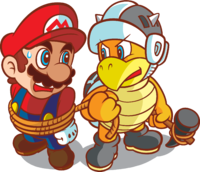
Mario once again ends up needing rescue during the events of Super Princess Peach. Bowser sends an army of Hammer Bros. (led by Army Hammer Bro) and Goombas to invade Princess Peach's castle. Mario, Luigi and the Toads, busy defending the castle, are subdued by the power of the Vibe Scepter and captured by a group of Hammer Brothers. Princess Peach is not in the castle at the time and so escaped the attack. Mario and the others are sent to Vibe Island, the source of the enemies' power. There they have no power to escape so Princess Peach, along with a magical umbrella named Perry given to her by Toadsworth, go there to rescue them. After defeating many of Bowser's minions and rescuing Luigi and a number of Toads, Princess Peach defeats Bowser using emotional powers called Vibes and Mario escapes himself. Princess Peach kisses him and he gives her a bunch of flowers.
Mario Hoops 3-on-3
In Mario Hoops 3-on-3, Mario is a default character. His Special Shot was the Fire Shot, which involves Mario dribbling the ball around him in the shape of an M and then either alley-oop or dunk a flaming red basketball into the hoop. To execute this move, the player must tap the touchscreen in the shape of the letter M. Mario is classified as a balanced character.
Mario Strikers series
In the Mario Strikers (or Mario Football in the PAL regions) series, Mario takes on yet another sport, soccer (also known as football). His stats are all-around in both games, Super Mario Strikers and Mario Strikers Charged. His Super Strike in Super Mario Strikers is the Fire Strike. His Super Ability in Mario Strikers Charged is Super Mario!. Unlike previous sports games, where Mario stayed in his usual traditional outfit, in the Mario Strikers series, he is seen wearing different gear, including different clothes and wearing cleats. In either game, Mario's team number is 1 and captain type is Balanced.
Mario & Sonic series
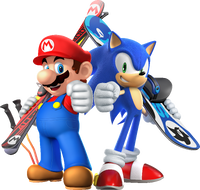
Mario also appears in Mario & Sonic at the Olympic Games, Mario & Sonic at the Olympic Winter Games, Mario & Sonic at the London 2012 Olympic Games and Mario & Sonic at the Sochi 2014 Olympic Winter Games. In all four games in the series, Mario is classified as an "All Around" character. He participates in a variety of Olympic events, such as swimming, track & field and archery. In the Adventure Tour of the DS version of Mario & Sonic at the Olympic Winter Games, he joins forces with Sonic the Hedgehog to save the Snow Spirits from Bowser and Dr. Eggman. Here, he finds fellow characters and completes their challenges so they can form a team to defeat Bowser and Eggman.
In Mario & Sonic at the London 2012 Games, specifically from the one for the Nintendo 3DS, Mario is a part of the "Heroes" group, which includes him, Luigi, Sonic and Tails. He can participate in events only when it involves this particular group. In the story mode, a thick fog has engulfed London, which has prevented events from happening, a scheme of Bowser and Eggman. Mario and his group also encounter foggy clones of themselves that challenge them to certain events. After the clones are defeated, the Heroes find machines responsible for the fog and destroys each of them. Bowser and Eggman resort to the fog to make themselves invincible, but the Heroes eventually beat them.
Mario reappears in Mario & Sonic at the Sochi 2014 Olympic Winter Games. Since there is no handheld version of the game, Mario does not participate in a specific story.
Mario reappears in Mario & Sonic at the Rio 2016 Olympic Games, as once again an All-Around type character. In the Nintendo 3DS version, along with Sonic, he is the only character that can be used for all events.
Throughout the games, Miis can don several costumes. Some resemble Mario's forms, such as Bee Mario, Propeller Mario and Fire Mario.
Mario Sports Mix
Mario appears in Mario Sports Mix. He is an All-Rounder type character and all of his stats are average. His stadium in the game is Mario Stadium. Most of his attacks involve spinning. In Basketball, he spins into his opponent if he is blocking his opponent for too long. In Hockey, his hits involve a two hit combo followed by a spin. In dodgeball, he rolls forward to avoid any incoming hit. In Volleyball, he spins when he spikes. In all sports, his special move is a fire blast that is so powerful that opponents have to resist the force while sliding backwards if they do not want Mario to score.
Fortune Street
Mario is a default character in Fortune Street, although he is playable only in the multiplayer mode, as all Mario and Dragon Quest characters in the game. As an opponent, he is Rank A, sharing with Bowser and Bowser Jr., making him the second-most difficult opponent to face. Also, as an opponent, he is able to speak in full sentences, a rare trait in the video games.
Puzzle & Dragons: Super Mario Bros. Edition
The story in Puzzle & Dragons: Super Mario Bros. Edition is similar ones in the more traditional Mario platformers. Princess Peach invites Mario to her castle to show him some bright Orbs that have appeared. When Mario arrives, however, Bowser abducts Peach and Kamek steals the power of these Orbs, causing more Orbs to scatter in the Mushroom Kingdom. Mario and Red Toad set out to rescue Peach by using these Orbs to attack enemies along the way. In the meantime, Mario can recruit enemies from Baddie Blocks and allies, such as Yoshis, that have been captured by Bowser. At Bowser's Castle, Mario defeats Bowser Jr. and Kamek several times. When Mario reaches and defeats Bowser, Bowser uses the Koopalings and Bowser Jr. together to attempt to beat Mario, but fails. Mario eventually rescues Peach.
Mario is among the first usable team members in Puzzle & Dragons: Super Mario Bros. Edition and either he, Luigi, or the duo's power-up forms (including Small Mario, Super Mario, Ice Mario, Racoon Mario, Fire Mario, Boo Mario, Penguin Mario, Flying Squirrel Mario, Bee Mario, Statue Mario, Cat Mario and White Tanooki Mario) can serve as leaders of the team. All of Mario and his various forms have the fire attribute in common.
Other appearances
Mario has made several appearances within his own series, but also outside as well. Mario has several small appearances within his series and related Nintendo games as well. Mario makes an appearance in Punch-Out!! for the NES. In the game he is only a referee for matches just like in Tennis for the NES. In Kirby Super Star and its remake, Mario makes a cameo as one of the several formations of the Stone ability, and is also seen in the crowd when Kirby is fighting King Dedede or participating in Megaton Punch Contest. Mario, voiced by Charles Martinet, is heard narrating Pac-Man Vs.. He is also featured in the built-in Augmented Reality Games as a Character Card, a traceable image and a stamp. Mario makes a cameo as a stamp for photos in the Game Boy Camera peripheral. It is seen also on the title screen dancing. His nose with his moustache also do make a cameo as a separate stamp. A Super Mario mash-up pack, released on May 17, 2016 for the Wii U version of Minecraft. features a playable Mario in the style of Minecraft.[11] It also features Mario's other forms as playable characters including Dr. Mario, Tanooki Mario, Propeller Mario, Fire Mario, Mario with F.L.U.D.D., Boomerang Mario, and Cat Mario.
Although Mario is Nintendo's biggest icon, he and his series receive considerably less merchandising compared to other icons such as Mickey Mouse. Nevertheless, Mario has several merchandising lines ranging from a Japanese plush series by San-ei, to a 2014 series of articulate action figures by Bandai Tamashii Nations SH Figuarts. Mario is also featured in a few food packaging, including Campbell's and gummies. Mario has a neon sign that depicts him. Mario T-shirts, toys and alike have also been produced and McDonalds released a chain of toys based on the popular Mario videogame Super Mario Bros. 3, as seen here.
Mario is also featured in a few non-video games that promote Nintendo, including Nintendo Monopoly, where he costs $400, replacing the Boardwalk, the most expensive space in the game. On the ? Block and Coin Block (later Block) cards he replaced Mr. Monopoly. Mario is also featured in Super Mario branded games including, but not limited to Super Mario Chess (the king) and Super Mario Checkers & Tic Tac Toe.
Cultural impact
Mario is often said to be the most famous video game character in history. A Q Score survey made in the early nineties showed Mario was even more popular than Mickey Mouse[12], and he has the only wax statue of a video game character, which stands in the Hollywood Wax Museum.
The Mario series is the best-selling video game franchise in history; the sales include 463.87 million, whereas the next best-selling franchise, Pokémon, totals 245 million. Even with subseries excluded, the main Mario series has sold 262 million games (as of March 2011).[13] Furthermore, Mario is the flagship series of Nintendo and Mario is the company's mascot, furthering his publicity even more. According to the Guinness World Records’ 2008 edition, Mario has appeared in a total of 116 separate games, which is more than any other video game character[14] and more recent sources such as the Game On 2.0 travelling exhibit place the number at over 200.[8]
General information
Physical description
Mario's distinctive look is due to technology restrictions in the mid-1980s. With a limited number of pixels and colors, the game developers, including Mario's creator, Shigeru Miyamoto, could not animate Mario's movement without making his arms "disappear" if his shirt was a solid color, so they gave Mario overalls. The developers additionally did not have the space to give him a mouth, the result of Mario's mustache. Finally, they used a cap to bypass the problem of animating and drawing hair.
Mario has underwent major changes since his initial appearance in Donkey Kong up until Super Mario Bros.. Although he has the general features such as the clothing and the mustache, it is not until Super Mario Bros. where he resembles as he is today. In Donkey Kong, Mario appears lankier with a more-realistic-looking red nose. In some portrayals in Donkey Kong Jr., however, he appears stouter with a round nose, which resembles more closely to Mario's current design, although some promotional art retain Mario's original Donkey Kong design. The stubbier design is retained in Mario Bros., with a few changes.
Since Super Mario Bros., however, Mario is depicted as a stocky, 26 year-old[15] man (though he was originally imagined as middle-aged) with a trademark hat, brown hair (although the DiC cartoons sometimes depict it as black), black or dark-brown mustache and overalls who is 155 cm (5 ft, 1 in) tall.[16] A contradicting source, however, has crossover artwork depicting Sonic the Hedgehog (who stands at 3'3") to be at least two or three inches taller. Merchandise for the original Donkey Kong showed Mario as balding, although most media depict Mario with a full set of hair. The most notable change Mario has received over the years since Super Mario Bros. (omitting stylistic variations such as depictions in Paper Mario) is his change in stature; Mario is shown to be much stubbier in his earlier appearances compared to his more recent appearances, starting with Super Mario 64. Mario's legs and arms have grown longer over the years, giving him a slimmer look. This may have been the result of Shigeru Miyamoto's response to their "cute" appearances, who considered redesigning them to "become a bit more grown-up" in the GameCube era, for instance by removing their trademark V sign.[17]
Mario from his Super Mario 64 appearance is depicted with darker blue overalls and bigger eyes than in his current appearance based from the one in Luigi's Mansion. He has a slightly darker skin and his ears are also rounder. His overall straps are longer and his cap is less round. Mario is overall less defined in the game artworks of the time due to the older software used to design him. The differences in Mario's 3D art over time, as a result, is more pronounced than the differences in Mario's 2D art since Super Mario Bros.. Ever since Luigi's Mansion, however, Mario has received only minor changes to his general appearance, such as added detail in his shoes, eyes and hat emblem in most game artworks since Super Mario 3D World.
Mario has a few stylistic variations across some games, sometimes within series. One variation is Mario's overall appearance in Paper Mario games is generally the same, with black dots for eyes and no eyebrows, although he has a shorter stature. Since Paper Mario: The Thousand-Year Door, however, Mario's body is more simplistic, with legless feet, a rounder face and a full outline around the arms. Another variation is Mario's depiction in the Mario & Luigi games, although it is more subtle, where Mario is given black eyes rather than blue.
Clothing
Mario is typically shown wearing his trademark outfit wherever he goes. He has a long-sleeved red shirt (short-sleeved in Super Mario Sunshine) which is tucked under a pair of white gloves and has a noticable collar at the neck. Layered over the shirt is a pair of blue overalls with yellow buttons. On his feet is a pair of light brown work shoes. In the Paper Mario series, these are known as boots and it is shown to have a rim on the top, although Mario's shoes in most media do not have this rim. In Super Smash Bros. Melee and Super Smash Bros. Brawl, Mario's dungarees are more realistic, resembling denim, and have additional details such as back pockets.
Originally, Mario wore red overalls on top of a blue shirt - nearly the opposite colors of what he wears now. The Famicom version of Mario Bros. is the first game to depict Mario with blue overalls and a red undershirt (although on the boxart, he is depicted entirely in blue), but Super Mario Bros. 2 standardized Mario's current colors.
Mario's trademark is his red hat with his red "M" insignia. Mario's hat is sometimes an important and even mandatory accessory in some games, such as in Super Mario 64, where he takes more damage without his hat. In Super Mario Sunshine, if Mario loses his hat, he will acquire damage over time from the heat of the sun. In most media, however, Mario's hat is treated as a mere accessory and Mario can go hatless in some games without any additional effect, such as in New Super Mario Bros. Wii. In some games, such as in Super Mario 3D Land, however, if Mario is in small form, he is seen without his hat, although it is no different from the other incarnations of the small form.
Mario has seen some variations to his outfit in the games. In Super Mario Sunshine, for instance, Mario has shorter sleeves. In addition, Mario can wear a tropical shirt over his normal shirt, along with sunglasses that darkens the screen, if he talks to the Sunglasses vendor. Mario also usually gains alternate outfits when using powerups, from simple recolors to covering his whole body such as Fire Mario, Tanooki Mario, Propeller Mario, Flying Squirrel Mario and Cat Mario. Finally, Mario can resemble different characters, even outside the Mario series by using a Mystery Mushroom to change into one of the various forms of Costume Mario in Super Mario Maker.
Although mostly seen with his default plumber attire, Mario has also worn several alternate outfits in the spin-off games including, but not limited to Dr. Mario, the Mario Strikers games, Mario's Picross and NES Open Tournament Golf.
Name
Mario's full name is given as "Mario Mario" in the Super Mario Bros. movie. In a few isolated cases, this has leaked into other media - for instance, the Prima guide book for Mario Party 2 lists his name as Mario Mario in a note section.[18] The Prima guide for Mario & Luigi: Superstar Saga similarly shows Mario's full name as Mario Mario in the list of major characters.[19] Also, when people asked Mario (voiced by Charles Martinet) what his last name was, he had responded with this: "My name's-a Mario Mario. Of course, my brother's name, a-Luigi Mario. And of course, my mama's-a Mama Mia Mario; my papa Papa Pio Mario. Of course, my grandmama Grandmama Mia Mario and my greatpapa et cetera, et cetera. Yeah, first name Mario, last name Mario. Yahoo!".[20] However, Nintendo of America has stated that "there are no last names."[21]Template:Deadlink This was also recently confirmed by then-Nintendo president Satoru Iwata.[22] In the games, additionally, Shigeru Miyamoto has stated that both Mario and Luigi's last names are anonymous and do not relate to their last names in the movie as seen above, although he has recently redacted that stance, stating at the Super Mario Bros. 30th Anniversary festival in September 2015 that Mario and Luigi's last names are indeed "Mario".[23]
Personality
Mario is known for being kind, cheerful, playful, courageous and headstrong and is also eager and cocky in certain occasions. Officially, however, Nintendo producers have stated that Mario's biography is kept simple in order to make the character versatile and reusable in many different games and situations. Mario is indeed one of the most underdeveloped characters in the Mario series. In fact, his brother Luigi has even gained a bit more of a personality in recent games. In most media and some games, though, Mario is depicted as an Italian plumber from Brooklyn [24] who stands for what is right and has a love for Italian food. Mario has proven himself to be a competent fighter, all-around sports player and party lover in Mario spin-off titles. Mario shows generally good sportsmanship for his wins and losses, even complimenting his opponent if he fails to be first, such as instances in Mario Kart 8 and Fortune Street. At a few other times, however, such as in Mario Kart 64, he is shown wiping a tear and in Mario Golf: Toadstool Tour, he throws a small fit. Finally, it has been said that Mario loves animals, especially the most unusual ones,[25] and he also enjoys music, particularly opera or new-wave Europop[25] although there is no further comment for these statements.
Mario has been shown on very occasions, such as certain cutscenes in Mario Power Tennis, but often in Super Mario-Kun, to have an almost overbearing attitude towards his brother. However, this could also just be Mario's outgoing "big brother" personality interacting with Luigi's more introverted nature. Additionally, Mario is much more impulsive and aggressive than his brother Luigi and is willing to enter dangerous situations all alone. Mario will often attempt to quickly solve a problem with his actions. Mallow even had to physically restrain Mario from brawling several times, such as before the battle with Bowyer, so that the heroes could figure out what exactly was happening to their world. While Mario will accept help and even partners during his adventures, at times he may also resent the implication that he needs the help in the first place. Despite this, he seems to enjoy their company. In the Super Mario-Kun, Mario is short-tempered and he resorts to yelling at his friends for failing or making uncalled-for actions. In Super Mario-Kun, Mario is not above in certain vulgar actions, such as farting to taunt his opponents or urinating on Yoshi and he also cross-dresses several times. The title itself and the artstyle of the Super Mario-Kun manga also depicts Mario with a childish personality. "Kun" is a generally masculine Japanese honorific for juniors such as boys or teenagers.
Mario seems to have a small fixation with food. This is most notably seen in the DiC cartoon trilogy, which may also be the origin of this trait, where Mario is almost constantly hungry and fascinated with Italian food (mostly pizza and pasta), typically wanting to stop Bowser's latest scheme simply so he could eat and going to nearly any length to do so. In fact, in the The Super Mario Bros. Super Show! episode "Koopenstein", when Princess Peach asked him if he ever thought about anything besides food, Mario, with pure honesty, replied, "What else is there?" As in Super Mario 64 and its remake, the original reason Mario came to the castle is that Peach was baking him a cake, which becomes a recurring trend in future games, such as in Super Mario Galaxy 2 and New Super Mario Bros. Wii, although Mario, as well as his friends, has also fallen for false invitations to a big feast, shown in Mario Party DS. In the opening of Super Mario Sunshine, Mario is apparently daydreaming about seafood. In Fortune Street, he offers Yoshi to help by finding Yoshi's cookies, but before playfully saying, "just give me a second to brush these cookie crumbs out of my mustache!" Quite a few characters in other games also advised Mario to refrain from eating much. For instance, when Mario holds to Hoot for too long, Hoot may complain about Mario's eating habits before exhausting and letting him go. Additionally, the Star Gate from Mario & Luigi: Partners in Time, while praising Mario for his pure heart, has criticized his diet, advising him to limit the Alfredo sauce and carbora in tandem with more exercising.
Speech
Like many other protagonists of Nintendo games, Mario rarely speaks, his dialogue primarily limited to numerous grunts and yells. When he does speak, he speaks English with a heavy Italian accent, often referring himself to the third person. In most games, with Charles Martinet's, his most recurring voice actor, voice-overs, Mario's voice is soft and high-pitched, but in a few other games and in the cartoons, Mario has a gruff voice usually associated with a Brooklyn accent. In the Mario vs. Donkey Kong titles, Mario speaks fully, shouting sentences such as "Come back here, you big monkey!" He can be clearly heard shouting, "Welcome! Welcome, new galaxy!" in the ending of Super Mario Galaxy, as well as saying "Thank you so much for playing my game!" after the credits. Mario has also been shown full capable speech in Itadaki Street DS and Fortune Street. Despite Nintendo's emphasis on Mario as a silent protagonist, Mario is the most often heard speaking in full sentences, if occurrences outside the games (especially in special events in real life) are counted.
In some cases, Mario is a true silent protagonist, or he does not speak in English. In Super Mario RPG: Legend of the Seven Stars, Mario is completely silent, communicating solely through pantomime. In the Paper Mario titles, he mainly communicates through simple nodding and hand gestures; while he is completely silent in Paper Mario, however, he is given grunts in the latter games. Mario is also silent during dialogue scenes in the Mario Baseball and Mario & Sonic series, although he can technically talk. In the Mario & Luigi titles, he and Luigi speak in unintelligible gibberish that the other characters can understand. In Super Mario Sunshine, Mario is "heard" speaking in the opening scenes, but his dialogue is completely inaudible, although this is present only in the American version of the game. In other versions, Mario is heard speaking coherently, such as saying "Looks like Mario's gonna have to find a job!" to Toadsworth after landing on Delfino Airstrip.
He has full speech capabilities in some sports games and outside games (including when being portrayed in real life) and also speaks regularly in the DiC cartoon trilogy, though he speaks perfect English with a Brooklyn accent in the latter. In a press conference, Mario is shown to be able to speak in full sentences.[26] Also, people can communicate with Mario by asking various questions; there, too, Mario can fully speak, although his Italian accent mostly disappears.[20][27][28] In the games, other characters speak for him, mainly Lakitu and Toad.
Powers and abilities
Mario's most notable ability is his Jump, which is his basic move he relies on to defeat enemies, avoid obstacles and activate helpful items such as ? Blocks and P-Switches. Although Luigi has superior jumping, Mario is more well-known. He is also capable of several acrobatic maneuvers, including the Long Jump, Back Flip, Spin Jump and Wall Jump, with the Wall Jump being one of his most recurring abilities. Mario can also use a variety of basic martial arts attacks, including punching and kicking, although he uses these moves the most in Super Smash Bros. games; in most games, jumping is his main form of attack. Mario's main weapon is the Hammer in Donkey Kong, although Mario often uses the Hammer as a weapon in Mario RPGs.
Mario is usually associated with fire in the the spin-offs, based on his Fire Mario form from Super Mario Bros. Mario can, in some games, such as Super Mario RPG: Legend of the Seven Stars, control fire without a Fire Flower power-up, although the first game where he actually starts using this power regularly is Super Smash Bros. Melee.
Mario has been shown to possess superhuman strength. In Super Mario World, he is seen lifting a fortress out of the ground and then kicking it away. In Super Mario 64, he can carry and throw King Bob-omb, although with some difficulty. During the battles with Bowser; Mario can grab him by the tail, spin him and throw him. His strength is also shown in Super Mario Galaxy, where he can easily stun a Mega Goomba with a Star Spin despite its great size and his ability to knock Bowser around during battles with him. In Bowser's Inside Story, although he is visibly straining, he is able to lift and throw a swelled Luigi when using the Snack Basket move. In the spinoffs, Mario, although usually balanced, boasts generally slightly higher-than-average power.
Mario has been designed to be a versatile character deliberately. As a result, whenever he appears in a game, his emphasis is always, in both spinoffs and mainstream games, a balanced playstyle, allowing him to participate and perform well in many situations. Indeed, his bios have frequently and consistently describe him as a "jack of all trades". Another result of his versatility is the among of occupations he holds, including being a plumber.
Mario can also take advantage of several powerups and transformations.
- Mario has fourteen power-ups that allow him to fly: the Wing, the Super Leaf, the Tanooki Suit, the P-Wing, the Cape Feather, the Power Balloon, the Wing Cap, the Power Flower, the Bee Mushroom, the Boo Mushroom, the Red Star, the Propeller Mushroom, the Invincibility Leaf and the Super Acorn. On The Super Mario Bros. Super Show!, Mario can fly even after powering up with a Fire Flower.
- In Super Mario Bros. 3, Mario can transform into a Hammer Bro with the ability to throw hammers at his enemies or a Frog which let him swim faster and jump higher.
- Mario has three other caps he can wear, the Metal Cap, Wing Cap and Vanish Cap, which turn him into Metal Mario, make him fly and make him invisible and intangible, respectively.
- In Paper Mario: The Thousand-Year Door, Mario becomes more paper-like and can become Flat Mario, Paper Tube Mario, Paper Airplane Mario and Paper Boat Mario as a result of the "curses" cast upon him by the Black Chest Demons.
- In Super Paper Mario, Mario was given the ability to flip between dimensions.
- In Super Mario World, Mario has the ability to run up walls and pipes.
Occupations
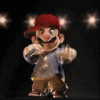
Mario is typically known as a plumber since Mario Bros., although he started as a carpenter in Donkey Kong. Although he is best known for being a plumber, the games rarely portray Mario being directly involved in plumbing. Other media, such as The Super Mario Bros. Super Show!, however, put a much bigger emphasis on Mario's job. According to the live-action segments in The Super Mario Bros. Super Show!, Mario works a menial job at Mario Brothers Plumbing in Brooklyn, just barely able to make enough money and sometimes complains about a dull life. Despite this, he and Luigi seem to excel at their jobs, as it is stated that they have one of the best plumbing in New York City. Also according to the show, Mario has received his plumber training from the Brooklyn Plumbers Academy, founded by Salvador Drainado, whom Mario holds to great respect. Mario is also skilled with various plumbing tools throughout the show's episodes, such as All Purpose Portable Plumber's Helper, Plunger and Plumber's Putty, which he uses to assist him and his friends in some hazardous situations.
In addition to plumbing, Mario has dabbled in various other occupations. One of his most notable recurring alternate careers is in medicine, as his alter-ego Dr. Mario, who stars in an entire spin-off series and is even a separate character in the Super Smash Bros. games. Mario is also known for his participation in a wide variety of spin-off sports games including, but not limited to golf, tennis, basketball, hockey, soccer and both kart and motocross racing. He also participates in a wide array of Olympic events and has even made a cameo as a referee in Mike Tyson's Punch Out!! Another subseries-specific recurring role Mario takes is as the president of the Mario Toy Company in the Mario vs. Donkey Kong games.
In addition to these, he has also had numerous one-off jobs, again including, but not limited to a demolition worker in Wrecking Crew, an archaeologist in Mario's Picross, a baker in Yoshi's Cookie, a factory worker in Mario's Cement Factory and Mario Bros. for the Game & Watch, a solider who delivers bombs in Mario's Bombs Away, a grocery worker in Super Mario Bros.: Peach-hime Kyushutsu Dai Sakusen! and potentially a sensei in Super Mario RPG: Legend of the Seven Stars. Finally, Super Mario Bros. & Friends: When I Grow Up depicts Mario in various occupations, intending to educate children on several careers they can explore.
Relationships
Family
Luigi is Mario's younger twin brother. Luigi often joins Mario on his adventures and the two of them are normally paired together in sports titles and spin-offs. They have a strong brotherly bond and will stop at nothing to help each other when one is in trouble, as seen in games such as Luigi's Mansion. It is stated in the 1993 official Nintendo Character Manual that Mario, when he retires, plans to give his plumbing business to Luigi (while also implying a distinct age contrast, which conflicts with the idea that they are twins).[25]
While they love each other, in Paper Mario, Luigi admits that he also feels jealousy towards his brother at times and has also expressed that he is "tired of being Player 2", for despite being a hero in his own right, he is often overshadowed by Mario. While Mario states that Luigi's quote of being Player 2 is taken out of context, adding that "Luigi loves being [his] sidekick" in the Mario Sports Mix press conference, in Mario & Luigi: Bowser's Inside Story, he is quick to give Luigi proper credit for defeating the Shroobs in the previous game. At times, Mario does exhibit a competitive sibling attitude toward Luigi, such as when he intentionally steps and squirms on Luigi's foot when the Luigi receives a trophy in Mario Power Tennis. In volume 36 of Super Mario-Kun, he also apparently ditches Luigi when Luigi is trapped in the Star Gate, much to Luigi's dismay, only to return quickly to see Luigi break into tears. Overall, however he acts as a good brother and role model for Luigi.
The rest of Mario's family have not been extensively explored, especially outside the games. Mario and Luigi's supposed parents make a cameo at the end of Super Mario World 2: Yoshi's Island, although their faces are not seen and their names are not given, same as in their appearances in Family Album "The Early Years" and Super Mario Issun-bōshi. Furthermore, Yoshi's New Island has stated that these two are not Mario and Luigi's parents. The Super Mario Bros. Super Show!, on the other hand, mentioned or featured Mama Mario in a number of episodes, depicting her as a strict woman who loves her boys very much. Their father did not appear in the show and very little is known about him. The Super Mario Bros. Super Show! and the comics also make references or depict various other relatives of Mario, including aunts, uncles and cousins, although none have appeared in any games.
Friends and love interests
One of Mario's earliest friends is Yoshi, who, along with other Yoshis, saved him and Luigi from the Koopas when they are still babies. In Yoshi's New Island, Mario has also reciprocated by traveling to the past to help Baby Mario and Yoshi save Baby Luigi. In the present day, Yoshi continues to help Mario against Bowser, usually serving as his steed. Another good friend of Mario's is Toad, who occasionally goes on adventures with him, as in Super Mario Bros. 2, various Mario cartoons and the Nintendo Comics System, where he is seen to be Mario's loyal and trusted sidekick. Toad trusts that Mario will always save the day and even when not fighting alongside him will be quick to offer advice and encouragement. In Mario & Luigi: Partners in Time, Mario has also shown to be a caring parental figure over Baby Mario, but he also steps in if any of his teammates misbehave. Mario appears to enjoy the babies' company. When Baby Mario finally returns to the present, he gives Mario his hammer, showing his pleasure to be with his adult self.
Mario saves Princess Peach quite often and she usually rewards him with a kiss him upon her rescue and often bakes him cake as well. They share good chemistry in sports games and have been good friends since childhood. The German Club Nintendo comic "Warios Weihnachtsmärchen", it is even revealed that they spent their graduation ball in school together and in the official guide of Yoshi's Island DS, the description for the level Baby Mario and Baby Peach: Dynamic Duo states they have teamed up as babies to stop evil before the "romantic entanglements" of their adult lives. While both Mario and Luigi deny a relationship when Luvbi asks if Peach was Mario's "lady friend", Luvbi also comments that the princess "looms large in his regard" and then wonders if Mario had a "one-sided crush". Many other sources, however, do portray Mario and Peach as having an ongoing romantic relationship, such as the official European Mario website listing Peach as Mario's girlfriend and Mario Party 5 calling Peach and Mario's team "Cutest Couple".
Peach has not been Mario's only romantic interest, however. In the original Donkey Kong, Pauline was Mario's first girlfriend and damsel-in-distress, but while he still has to occasionally rescue her in the Mario vs. Donkey Kong series, the two are considered just friends now. In addition, when Mario saved Princess Daisy in her debut appearance in Super Mario Land, a heart appeared overhead, implying a romantic connection. This was never explored further, however and while Mario Party 4 gave them the team name "Nice Couple", most games link Daisy with Luigi instead, with her and Mario simply being friends, not even sharing any player chemistry in the Mario Baseball series.
Throughout his adventure, Mario has also befriended numerous characters, notably his partners in the Paper Mario series. His partners are loyal to him and some, such as Vivian, even have developed somewhat of a crush on him, whereas Ms. Mowz often flirts with him. Several other characters, especially in the Mario RPGs, including Toadette are also wooed by Mario's heroic antics, although Mario himself has shown little interest. Mario has also made friends with characters outside the Mario series. For instance, he teamed up with Kirby, Link and even Mega Man in the German Club Nintendo comics.
Foes and rivals
Bowser is Mario's arch nemesis and the two are locked in a neverending cycle of conflict. Bowser constantly tries to take over the Mushroom Kingdom and kidnap Peach and each time he upsets the peace, Mario stops at nothing to defeat him and set things right. Bowser often calls Mario a variety disparaging nicknames, especially in the cartoons. Mario sometimes returns the insults, but such retorts are usually restricted to the cartoons and other non-game media, since Mario is portrayed as silent, if not more cheerful and polite. When Mario does lose Bowser, he acknowledges it in good nature such as in Fortune Street, although he expects himself to be a competent adversary for Bowser. Occasionally the two team up to defeat greater evils, such as in Super Mario RPG: Legend of the Seven Stars, Mario & Luigi: Superstar Saga and Super Paper Mario and while Bowser openly hates Mario and resents him for his close relationship with Peach, for his part, Mario has never truly shown hatred nor contempt against Bowser and he is often more than happy to forgive Bowser after he defeats him, such as in Mario Party DS, where they enjoy playing Triangle Twisters together.
Bowser is not Mario's only foe, however and in the original Donkey Kong, it was Cranky Kong (then known as "Donkey Kong") that Mario had to defeat. The current Donkey Kong and Mario are on much better terms and often participate in sports and spin-offs together. Although they do maintain a friendly and somewhat competitive rivalry, Mario must defeat Donkey Kong a couple times in the Mario vs. Donkey Kong series because Donkey Kong went into mischief, stemming from his passion and frustration for Mini Marios and Mario's ex-girlfriend Pauline. Even after his victory, after noticing Donkey Kong upset, Mario reconciles by offering his toys.
Mario's main rival, however, is Wario. Various comics depict their antagonistic relationship starting in childhood and it is a major theme in the Super Mario-Kun manga. In Wario's first appearance, Super Mario Land 2: 6 Golden Coins, he stole Mario's castle and in Mario Super Sluggers, he tried to destroy Mario, although for the most part, their rivalry is far more mild in nature and the two even team up to defeat Bowser in Super Mario 64 DS. Nintendo Power has stated that Wario is Mario's cousinTemplate:Refneeded, but this is unconfirmed. Finally, according to Wario in Wario's Warehouse, both Wario and Waluigi hang out with him, although Mario frequently peeks at Wario's Warehouse. Wario has shown mostly contempt for Mario, but he does not share the same level as dislike as Bowser, whereas Mario, although he has been initially bitter and even called Wario an "evil creep",[29] maintains his cheerful and positive attitude as he does with most of his enemies.
Mario appears to be friendly rivals with Sonic the Hedgehog, as the two have teamed up several times to stop Bowser and Dr. Eggman. They appear to be extremely competitive in sports and events, however, often trying to see who is faster. According to an informal conversation with Mario, Mario stated in response that he likes Sonic and views him as a friendly archrival than an enemy.
List of game appearances
This is a list of game appearances for Mario. Minor appearances, including cameos, are not counted.
Official profiles and statistics
- Main article: List of Mario profiles and statistics
Mario has consistently and frequently appeared in every game as a balanced player designed to be mastered easily. The only notable exceptions are the Mario Golf games, where he has a high drive, higher than most of the cast, including known-power characters such as Wario and Donkey Kong (in Mario Golf: World Tour, for instance, his drive is surpassed only by Bowser and Rosalina). Otherwise, since Mario is designed as a versatile character, his stats reflect the "jack of all trades" quality. In games where Mario's stats are not equally balanced, he generally leans slightly toward power. While Mario is fairly nimble in games such as Super Smash Bros., Mario Super Sluggers, the Mario & Luigi series and in the Mario & Sonic series, he is sometimes portrayed with average or even below-average mobility in other games including Mario Superstar Baseball, Mario Tennis games and Mario Strikers Charged.
Most bios have described Mario as a well-known icon in Mushroom Kingdom, Nintendo and in video gaming in general. They may also celebrate his numerous accomplishments or his previous forays.
Mario's most frequent associated color scheme has been red, although his scheme may sport blue or white motifs. His logo is his trademark M cap.
Portrayals
Mario has been voiced by the following people:
- Tōru Furuya - Super Mario Bros.: Peach-hime Kyushutsu Dai Sakusen!, Amada Anime Series: Super Mario Bros., Super Mario World: Mario to Yoshi no Bōken Land, Satellaview games.
- Lou Albano - The Super Mario Bros. Super Show!
- Walker Boone - The Adventures of Super Mario Bros. 3, Super Mario World
- Ronald B. Ruben - Mario Teaches Typing
- Takeshi Aono - Mario Paint commercial
- Bob Hoskins - Super Mario Bros.
- Marc Graue - Hotel Mario
- Nick Glaeser - Mario is Missing! (MS-DOS, CD-ROM Deluxe)
- Charles Martinet - Mario's Game Gallery - present
- Gorō Inagaki - 2003 "Hot Mario" commercial
- Takashi Okamura - 2005-2006 "Hot Mario Bros." commercials
- Kazunari Ninomiya - 2011 Super Mario 3D Land and Mario Kart 7 commercials
Gallery
- Mario MB.png
- Mario SMB.png
- Mariopaintart1.PNG
- PM Mario.gif
Quotes
- Main article: List of quotes by Mario
Games
- "Lets-a play!" - Mario Tennis: Power Tour/New Super Mario Bros. Wii/Super Mario 3D Land
- "It's-a me, Mario!" - Super Mario 64
- "Press Start to play." - Super Mario 64
- "Let's-a go!" - Various games
- "Here we go!" - Various games
- "Thank you so much for playing my game!" - Super Mario 64/Super Mario 64 DS/Super Mario Galaxy/Super Mario Galaxy 2
- Variations of "Mario time!" - Various games
- "Here I go!" - New Super Mario Bros.
- "That's so nice!" - New Super Mario Bros.
- "Mama mia!" - Various games
- Variations of "Yahoo!" - Various games
Mario comics
- Main article: List of quotes in Mario Comics § Mario
Mario cartoons
- The Super Mario Bros. Super Show!
- Main article: List of quotes in The Super Mario Bros. Super Show! § Mario
- The Adventures of Super Mario Bros. 3
- Main article: List of quotes in The Adventures of Super Mario Bros. 3 § Mario
- Super Mario World
- Main article: List of quotes in the Super Mario World television series § Mario
Names in other languages
Trivia
- The 1993 Nintendo Character Guide classifies Mario under the species "homo[sic] nintendonus".[30]
- According to the Insiders' Calendar included in the second issue of Nintendo Power, Mario's birthday is October 11th.
References
- ^ http://us.wii.com/iwata_asks/mario25th/vol2_page4.jsp
- ^ http://games.ign.com/articles/833/833615p1.html
- ^ Scullion, Chris. (April 30, 2010). "10 Amazing Mario Facts". The Official Nintendo Magazine It is stated that Jumpman was renamed in honour of the warehouse landlord, Mario Segale, following an altercation between him and a Nintendo employee. (Retrieved December 23, 2011)
- ^ Pryne, Eric. (March 27, 2010). "Powerful Segale family has massive vision for Tukwila expanse". The Seattle Times. Excerpt: ""You might say I'm still waiting for my royalty checks," Segale told The Seattle Times in 1993. He didn't confirm widely circulated stories that "Super Mario" got his name after Segale stormed into Nintendo's office, angrily demanding overdue rent. But many business associates say those tales fit the Mario they know — a hard-driving businessman who can be warm and generous, but also can display a temper when he doesn't get what he wants.. (Retrieved December 19, 2011)
- ^ Edwards, Benj. (April 25, 2010). "The True Face of Mario". Technologizer. It is reported that it was Nintendo of America president Minoru Arakawa who noticed the similarities between their Donkey Kong character and Mario Segale. (Retrieved December 19, 2011)
- ^ Thiel, Art. (2003). Out of Left Field: How the Mariners Made Baseball Fly in Seattle. Sasquatch Books. pp. 44–45. Another recount of the Mario Segale encounter that led Minoru Arakawa and the other NOA employees to name their character "Mario". (Online book accessed December 19, 2011)
- ^ Nintendo of Europe. There are so many myths about Mario… Mr Miyamoto reveals the truth. Twitter. (Retrieved September 10, 2015).
- ^ a b Game On 2.0 travelling exhibition. The history of Mario feature discusses the origins of Mario's design, name and occupation as a plumber. Photo taken July 21, 2013.
- ^ a b https://www.youtube.com/watch?v=xWVpFD_A5Rs
- ^ An alternate box art of Mario is Missing! sported the "Mario Discovery Series" symbol.
- ^ Nintendo. (May 9, 2016) Super Mario Mash-Up Pack for Minecraft - Wii U Edition. Youtube. Retrieved June 10, 2016.
- ^ http://www.guardian.co.uk/technology/gamesblog/2010/sep/13/games-gameculture
- ^ http://www.businesswire.com/news/home/20110531005315/en/Nintendo-DS-Lite-Suggested-Retail-Price-Drops#.UyJ5XYVI8UJ
- ^ http://videogames.yahoo.com/events/plugged-in/groundbreaking-hit-super-mario-bros-celebrates-25th-birthday/1410955
- ^ [1]
- ^ http://kotaku.com/186665/five-foot-tall-mario-statue-for-sale The Japanese poster says "Life-size Mario!!"
- ^ IGN (Accessed on 7-6-09)
- ^ Barton, Jeff, Mario De Govia, Tri Pham, and Donato Tica. Mario Party 2 Prima Official Strategy Guide, page 5.
- ^ Stratton, Stephen, and Levi Buchanan. Mario & Luigi: Superstar Saga Prima Official Strategy Guide. Page 21.
- ^ a b http://www.youtube.com/watch?v=AAjhjLuWbC8
- ^ [2]
- ^ http://kotaku.com/5935721/super-marios-boss-doesnt-want-to-overdo-it-with-mr-video-game-and-wont-deceive-you-with-dlc
- ^ Cite error: Invalid
<ref>tag; no text was provided for refs namedfull name - ^ http://uk.youtube.com/watch?v=ZnSi7ihAhsQ Retrieved 28th July 2007
- ^ a b c Green, Matthew. (December 30, 2014). Mario, Kirby, And Samus Aran Shine In The Nintendo Character Manual. Press The Buttons. Retrieved February 16, 2016.
- ^ http://www.youtube.com/watch?v=eQVjYNE2Kew
- ^ http://www.youtube.com/watch?v=9ihWsOcbS_E
- ^ http://www.youtube.com/watch?v=atM5ZjqVVE4
- ^ Super Mario Land 2: 6 Golden Coins instruction booklet. "While I was away crusading against the mystery alien Tatanga in Sarasa Land, an evil creep took over my castle and put the people of Mario Land under his control with a magic spell. The intruder goes by the name of Wario. He has been jealous of my popularity ever since we were boys, and has tried to steal my castle many times. It seems he has succeeded this time. Wario has scattered the 6 Golden Coins from my castle all over Mario Land. These Golden Coins are guarded by those under Wario's spell. Without these coins, we can't get into the castle to deal with Wario. We must collect the six coins, attack Wario in the castle, and save everybody!"
- ^ Devore, Jordan (August 5, 2014). Yoshi is properly known as T. Yoshisaur Munchakoopas. Destructoid.
- Humans
- Plumbers
- Heroes
- Cloned
- Hostages
- Kings
- Magicians
- Merchants and Salespeople
- Pirates
- Police
- Royalty
- Shapeshifters
- Shopkeepers
- Twins
- Siblings
- Villains
- Captains
- Allies
- Bosses
- Forms
- Unlockables
- Characters
- Playable Characters
- Final Bosses
- Amiibo with Special Editions
- Dance Dance Revolution: Mario Mix
- Donkey Kong (game)
- Donkey Kong Characters
- Donkey Kong Enemies
- Fortune Street Characters
- Hotel Mario
- Itadaki Street DS Characters
- Mario & Luigi: Bowser's Inside Story
- Mario & Luigi: Dream Team Characters
- Mario & Luigi: Superstar Saga
- Mario & Sonic at the London 2012 Olympic Games
- Mario & Wario
- Mario and Donkey Kong: Minis on the Move
- Mario's Early Years! Preschool Fun
- Mario Golf 64
- Mario Golf Characters
- Mario Golf GBC
- Mario Golf: Advance Tour
- Mario Golf: Toadstool Tour
- Mario Golf: World Tour
- Mario Hoops 3-on-3 Playable Characters
- Mario Hoops 3-on-3
- Mario is Missing!
- Mario Kart 64
- Mario Kart 7
- Mario Kart 8
- Mario Kart DS Characters
- Mario Kart Series Playable Characters
- Mario Kart Wii Characters
- Mario Kart Wii Trading Cards
- Mario Kart: Double Dash!! Characters
- Mario Kart: Super Circuit
- Mario Paint
- Mario Party 2
- Mario Party 3
- Mario Party 4
- Mario Party 5
- Mario Party 6
- Mario Party 7
- Mario Party 8
- Mario Party 9
- Mario Party 10
- Mario Party Advance
- Mario Party Characters
- Mario Party DS
- Mario Party
- Mario Party: Island Tour
- Mario Pinball Land
- Mario Power Tennis Characters
- Mario Sports Mix
- Mario Strikers Charged Characters
- Mario Super Sluggers Playable Characters
- Mario Superstar Baseball Characters
- Mario Tennis 64
- Mario Tennis GBC
- Mario Tennis Open
- Mario Tennis: Power Tour Characters
- Mario Tennis: Ultra Smash
- Mario vs. Donkey Kong 2: March of the Minis
- Mario vs. Donkey Kong: Mini-Land Mayhem!
- Mario vs. Donkey Kong: Minis March Again!
- Mario vs. Donkey Kong: Tipping Stars
- Mario's Tennis
- Mario's Time Machine
- Mobile Golf
- NES Open Tournament Golf
- New Super Mario Bros. 2 Characters
- New Super Mario Bros. U
- New Super Mario Bros. Wii Trading Cards
- Paper Mario Characters
- Paper Mario: Color Splash Characters
- Paper Mario: Sticker Star Characters
- Paper Mario: The Thousand-Year Door Characters
- Puzzle & Dragons: Super Mario Bros. Edition
- Super Mario Advance
- Super Mario Advance 4: Super Mario Bros. 3
- Super Mario 3D Land
- Super Mario 3D World
- Super Mario amiibo Line
- Super Mario Bros. 2
- Super Mario Bros. Deluxe
- Super Mario Bros.
- Super Mario Galaxy 2
- Super Mario Galaxy Trading Cards
- Super Mario Land 2: 6 Golden Coins
- Super Mario Land
- Super Mario RPG Characters
- Super Mario Strikers Characters
- Super Paper Mario Characters
- Super Princess Peach
- Super Smash Bros. amiibo Line
- Super Smash Bros. Bosses
- Super Smash Bros. Brawl Fighters
- Super Smash Bros. Brawl
- Super Smash Bros. for Nintendo 3DS / Wii U Fighters
- Super Smash Bros. for Nintendo 3DS / Wii U
- Super Smash Bros. Fighters
- Super Smash Bros. Melee Fighters
- Super Smash Bros. Melee
- Super Smash Bros. Stickers
- Super Smash Bros. Trophies
- Yakuman DS
- Yoshi's Safari

